Architectural Sessions at the Parrish
Quiet Architecture: Thomas Phifer and Gabriel Smith in Conversation with Maziar Behrooz.
In association with AIA Peconic.
NOTE: AAQ Museum Architecture portfolio — Glenstone, Potomac, Maryland. Glenstone opened in October, 2018.
Lichtenstein Theater, Parrish Art Museum, Water Mill, New York September 15, 2013 Andrea Grover, Curator of Special Projects: I want to tell you a little bit about tonight’s program by starting with a quote by Thomas Phifer: “We’re into very quiet architecture. Our buildings want to be helping hands, bringing people closer to understanding the sun and light and the change of seasons. For far too long buildings have been fortresses cutting people off from nature.”This session will examine this particular focus of the Phifer firm and how this gridline goes through projects from conception to completion.
Thomas Phifer founded his New York City based firm, Thomas Phifer & Partners, in 1997. The firm has recently completed the North Carolina Museum of Art in Raleigh and the Brochstein Pavilion at Rice University, as well as a number of residential commissions. Current projects include an expansion of the Corning Museum of Glass, a new museum for the Glenstone Foundation in Potomac, Maryland, and a federal office building in San Juan, Puerto Rico.
The firm’s buildings have received numerous AIA national and New York honor awards. Phifer has received a Medal of Honor from the NY Chapter of AIA and the Grand Prize from the American Academy in Rome, and in 2013 the Arts & Letters award in architecture from the American Academy of Arts & Letters.
He has taught at numerous architecture schools, including Cornell University, University of Pennsylvania and the University of Texas.
Joining him today is Gabriel Smith. Gabriel Smith joined Thomas Phifer & Partners in 2005 and became a director in 2010. Mr. Smith has extensive experience with designs for museums and cultural institutions. He worked for the offices of Skidmore Owings & Merrell, Norman Foster & Partners, Allied Architecture + Design, Eskew+Dumez+Ripple Architects in New Orleans, where he served as a project architect for the University of Louisiana, Lafayette Art Museum, in Lafayette. He received a BA and MA from Tulane University and a Master of Architecture from Harvard University’s Graduate School of Design. He is a LEED accredited professional, a member of the American Institute of Architects and is a registered architect in the state of Louisiana.
Maziar Behrooz has been working out here since 1996 when he founded MB Architecture. He studied at Tulane School of Architecture, the Institute for Architecture and Urban Studies and Cornell’s School of Architecture. He is a member of the AIA, USGC, and the Tulane University of Architecture Board of Advisors.
————————————————————————————————————————————————

Thomas Phifer & Partners, NYC
MB: I visited their office a few months ago, and I had seen this photo on their website, showing this long desk in the center, displaying a really remarkable lack of clutter. I thought this was probably attributable to this photograph having been taken very early on when the firm opened. When I came to the studio, I was struck by how this image really does reflect this space. If this were a young firm with little work that would be expected. I am really curious how you manage to keep an office, not just organized, but also with a sense of openness about it, and I could see the research going on. I think it is important to you and your work.
TP: I really like the idea of people talking about work. You go into lots of places where people work and they’re cordoned off, they’re in cubicles, they’re in private offices. They just don’t talk to each other, they don’t communicate, they don’t work together.
I think architecture is a very complicated profession. It takes a lot of different disciplines; it takes a lot of different points of view; it takes a lot of collaboration. And, what we found with this kind of long dining table–it’s like a Shaker dining table–that the better the computer screens get, the less invasive they get on the table, the more people begin to interact and talk together. If you can find that balance of people working together with a sense of community, I think it reinforces the spirit of the architecture to be made, and how that all gets gathered together.
MB: I felt that sense of collaboration and conversation amongst people in the office. I know that you worked at Richard Meier’s office. One of our members here, Steve Lesser, was also there for many years. And once he described to me the filing system at Meier’s office. I don’t know if you brought that with you or if you replaced it, because I know that translates into construction documents and drawing sets and eventually the building itself, the way you organize yourself and your paperwork…
TP: When I was with Richard, we did a lot of work in Europe and we worked with European architects, particularly Germans. They have a particular way of filing things, a particular way of making drawings, a particular way of storing drawings, and all with this German binder system, the way they fold things. And, it was impressive. It was really organized. They didn’t have drawings out on the table — they had a binder. And, I think we tried to adopt that spirit the way that we organize work. I did that for a long, long time and I think that became ingrained a bit.
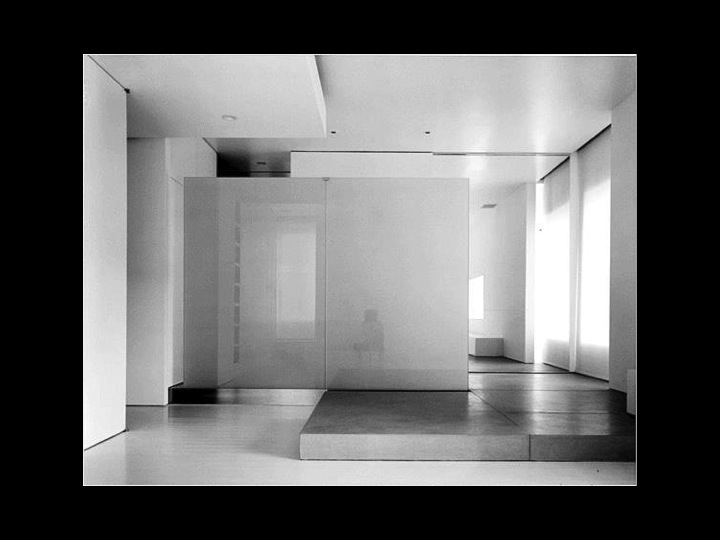
Zen-like White Apartment by Daniel Rowen
MP: This is an image of a project by a dear friend, who was a member of our chapter, Dan Rowan–he passed away a few years ago. He was a remarkable architect and human being. He was a very active member of our chapter, and now our awards program is named after him. What was your relationship professionally with Dan?
TP: I marvel at this project — it was his favorite project. I met Dan in 1980 and we were close friends for thirty years.
MP: He taught me many things. After his passing, I don’t know whom I spoke with who said he was responsible for the de Menil house being mirrored. Is that true?
TP: Yes. He actually lived in the de Menil house. Charlie cursed him out for that — suggesting the plan be mirrored — but the next morning flipped it like Dan wanted.
MB: That was Danny — classic Danny — undeniable logic.
TP: He was incredibly quick — an amazing mind. And I learned so much from him.
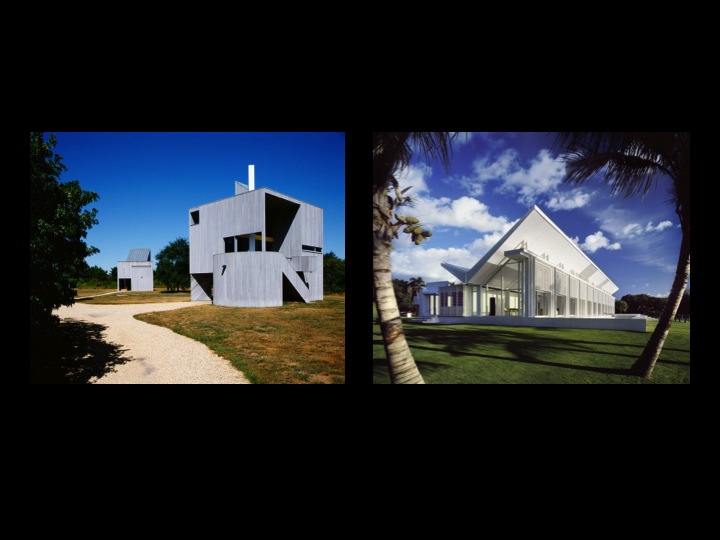
Charles Gwathmey, left. Richard Meier, right.
MB: These pictures of Charlie Gwathmey on the left, one of his first projects — on Bluff Road, Amagansett — and a project by Richard Meier on the right. The influence of Gwathmey & Meier must be strong and, not only that, but the New York Five book.
TP: I think I must have been the first person in the south to buy that book in 1975. I am amazed that it was actually published.
Audience: What is the New York Five book?
MB: Five Architects was a book that came out in the mid-70s. And it was simply called Five Architects — a square book, white cover with black type; and it included the work of five young architects — upcoming architects at the time — including Gwathmey, Graves, Hejduk, Meier and, Eisenman.That book really, for me, changed the course of my thinking about architecture.
TP: That was an incredible thing. Charlie’s house — I went there often with him. And, I think that, particularly as I get older as an architect, seeing Charlie in that house, building that house, starting his work in that house, becomes more and more powerful for me. It is really an extraordinary work. And, of course, Richard Meier’s house that we did together in Florida. Richard taught me about light.
MB: You were very involved in that project.
TP: You know the funny story about this house. We worked on an island with very strict regulations. They had a regulation that you couldn’t build a flat roof house and you had to have a particular pitch. We flipped it, and they got really upset. They had no way to turn it down. And after we built the house, they changed that regulation, saying that you couldn’t flip it — it had to be this way [pitch up] and not that way [pitch down]. So, that house is there by good graces.
MB: I am glad that they changed the law afterwards, but then you made it harder for everyone else.
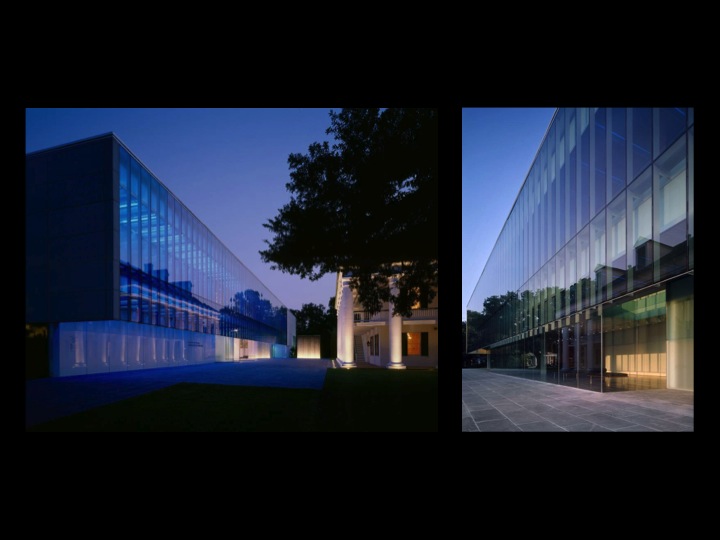
Paul and Lulu Hilliard University Art Museum, Lafayette, Louisiana
MB: This project is not Tom Phifer’s work. This is a project that Gabe Smith was project architect on, and was responsible for, while he was with the firm Eskew Dumez Ripple in New Orleans.
GS: The funny story here is, I had never met Tom or even thought I would be in New York but he had been on an Awards Jury that we had submitted for. I was forty years old in New Orleans and Katrina came along. We spent the first two weeks after the storm at my in-laws house, who are in the audience here. We thought we would go back to New Orleans and everything collapsed — jobs, health insurance, and we had a couple of kids — so I got my portfolio out and went to James Carpenter’s office who was a consultant for my firm in New Orleans. He introduced me to Tom. I walked in the door, opened my portfolio, and we had a very short conversation.
MB: You still apparently have very short conversations.
GS: We kind of read each other’s minds a little bit. In an odd way our connection is through Lafayette, Lousiana, in a very roundabout way.
MB: When I pulled this project to represent the work that you were responsible for, I didn’t know about this connection.
GS: I also saw a really good lecture by Charlie Gwathmey in Tulane and everybody was doing Gwathmey-like work after that. We kind of worked around the same ideas — there’s a language -– so there’s a familiarity, a bit of a connection back into the 80s.
__________________________________________________________________________
Taghkanic House, Hudson Valley
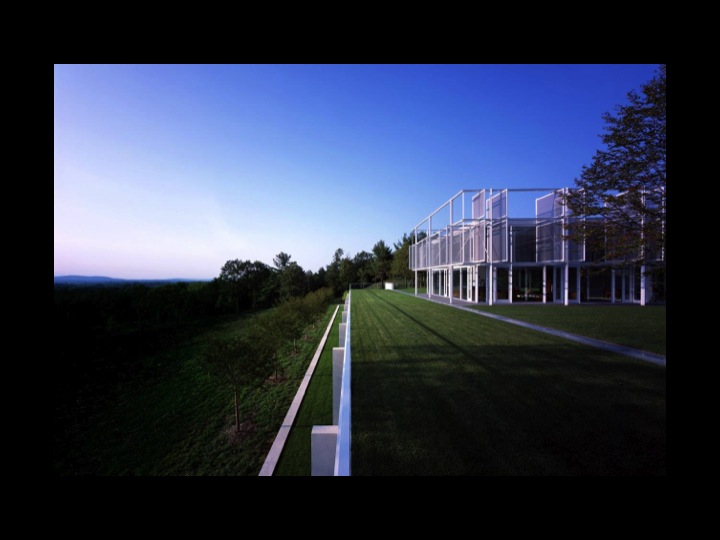
MB: This is the Taghkanic House, and it’s one of the first projects that you did after you went on your own.
TP: The very first project.
MB: You had finished working for Meier ten years and you spent a year in Rome, then you decided to open an office. Prior to that you worked on very large projects in Meier’s office and suddenly you are on your own, and you have a house commission. Are you worried at this point that you will even survive, let alone do well?
TP: Panicked. I spent a year in my living room and I spent a year in an office space with no one else. I spent two years alone, trying to get work and trying to start the practice. We were lucky to get this client. A very unusual site…. It was owned by the Rockefellers, and Peggy Rockefeller put an X on the only place you could build on this 300 acre site. This was the place. The real great story behind this was working with Dan Kiley, the great, great landscape architect, who was a real mentor to me. I had never done a project out in a landscape before, and we talked for a long time about what it meant to build on the land, under the land — what it meant to take on a larger landscape. It was a really important project to get started.
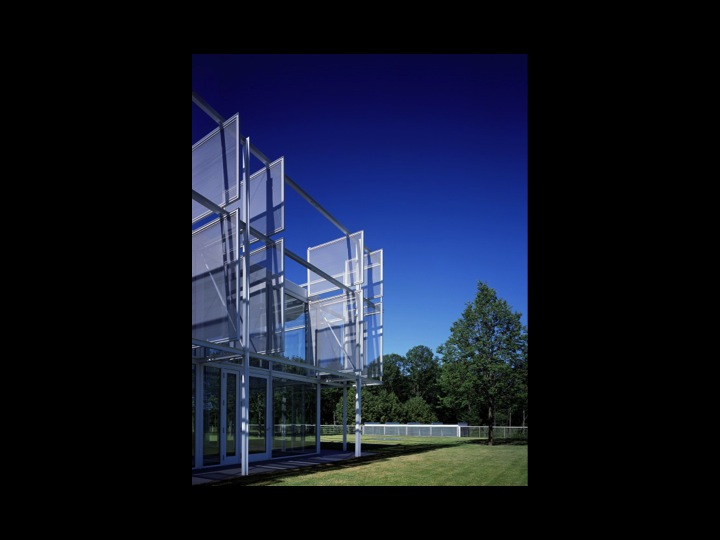
MB: There’s a beautiful metal screen all around the building, and, in fact, the grass covered podium is really a rooftop.

TP: It is really a rooftop that covers all the privates spaces — the bedrooms, the master spaces. The public spaces are upstairs. The edge of the retaining wall is lined by a long skylight on both sides. The larger pieces of glass let light down into the (private) space.
__________________________________________________________________________
Dan Graham Curved Wall

TP: Dan Graham’s work, for me, grounds this work in its place through its reflection, through its transparency, through its kind of reflectance of the character and quality of light. It marks this place. Where one could say that the materials mark a place in the ground. This work comes from the light and atmosphere — the changing light, the changing seasons, the changing color of light, the poetics of the atmosphere — all get absorbed in this work. That’s why this is so important to us.
MB: Colin Rowe wrote an essay about phenomenal and literal transparency.
GS: Transparency: Literal and Phenomenal. It’s an essay I have used in teaching. This is one of the reasons, these works of art, this group of artists, including Irwin’s work, is so important. There is another book, Seeing Is Forgetting The Name Of The Thing One Sees [: A Life of Contemporary Artist Robert Irwin, 1982]. It’s about art that requires engagement. And, I think that while we are at once absolutely fascinated by these works of art that are ephemeral and that are fleeting and almost teetering on failure….when you go to see a great piece of architecture — it is undeniable that you are in a beautiful space. You can’t talk about it because it would take thousands of words to describe. That is one of the things when we talk about buildings together that is so much fun — we don’t have to talk a lot — we go, ‘That’s it!’
__________________________________________________________________________
Sagaponack House
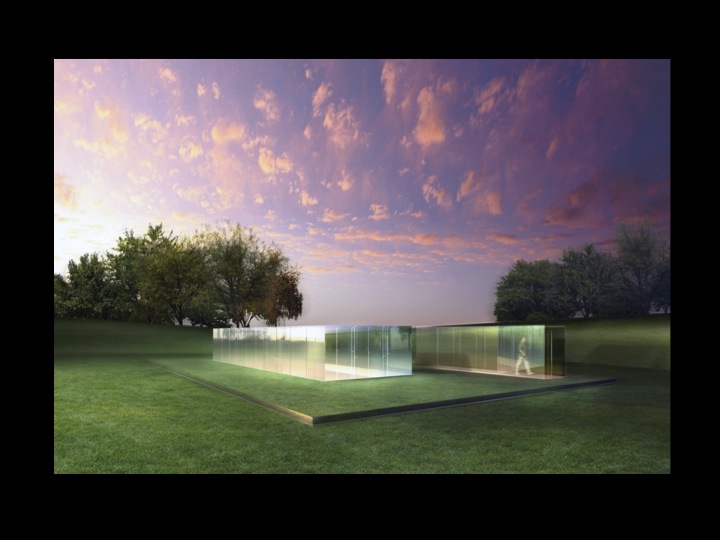
Sagaponack Houses Development Project
MB: This project which is also an early work. A project for Sagaponack. It is included in the development that Richard Meier initiated. A few years ago it was taken over by another company. A number have been built — will this have a chance to be built?
TP: Not this one. This was a reaction to a site that didn’t have a lot of privacy, so we conceived this bowl — this grass on a very flat site in Sagaponack. We conceived a house that was in the earth. We conceived this idea of glass on top. At some moments having reflectance, you walk down the stairs, you are in the garden, you come to the courtyard — you are still in the house, the house surrounds the courtyard — but, when you are in the courtyard, these glass panes become periscopes. We did a lot of experimentation to see what the reflectance was off those reflecting the landscape above. And, this turned out to be a very important house for us.


TP: This is actually the Sagaponack House…This was our scrim house. These panels were spread doors that opened up, and closed up. Very, very simple house that actually became a pre-manufactured house. We had all these components built in a factory. They could assemble the house in a couple weeks.
MB: You developed it to that point?
TP: Yes, to that point, but Coco Brown passed away, sadly. [Coco Brown was the developer of the Sagaponack Houses project.]
__________________________________________________________________________
Armstrong House, Fishers Island

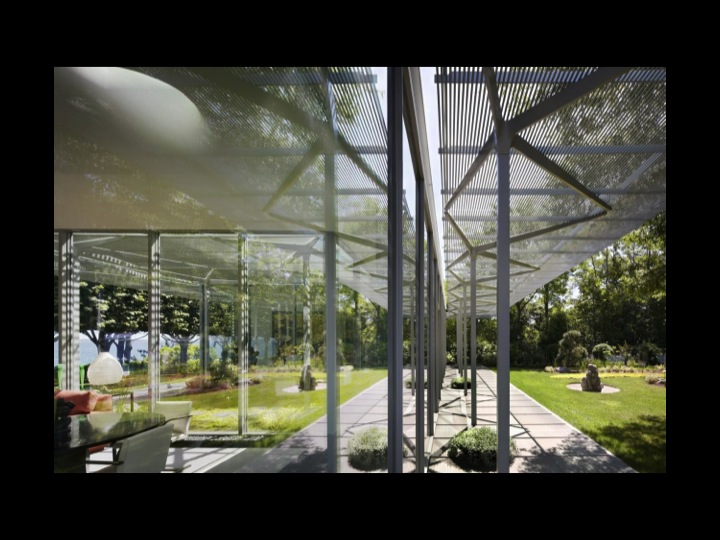
TP: This was one of the first houses we did with a scrim-style porch. It opened to Tom Armstrong’s garden — it was a house that really opened out to the garden that he had been working on for fifteen years. His house had completely burned to the ground, not touching the garden, so we put this house in the existing garden. The building has a certain transparency and accepts the garden inside the house.
MB: That trellis is so delicate and paper-thin. Is it steel?
TP: The columns are steel, the little beads are steel, but the little tubes are aluminum.
__________________________________________________________________________
Salt Point House, Hudson Valley
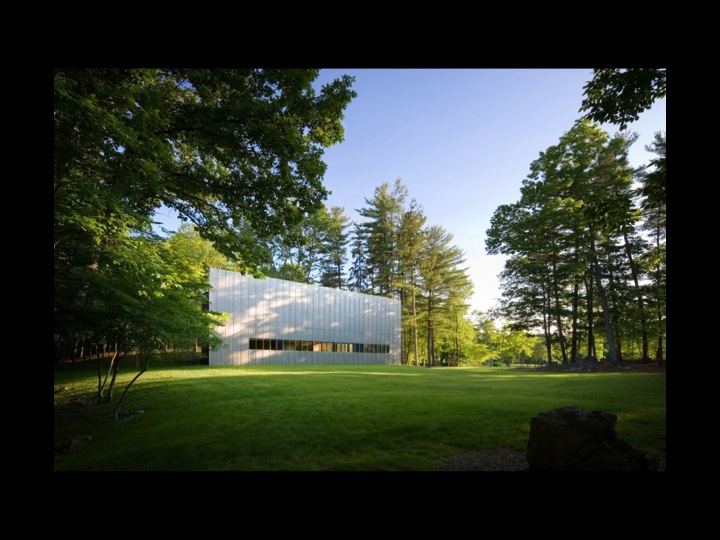
MB: Tell us about the relationship of this project to its environment. I was speaking to a landscape architect just yesterday, who kept talking about integration with nature. To me, this way of intervening or inserting the project in nature — without really altering it — is a kind of a form of deep respect for its environment .
TP: We looked for a long time about what to make — at this point a little bit like Dan Graham’s — we wanted a house that would blur the boundaries between nature and architecture. We finally found this perforated stainless steel that, by overlapping, would blur the edges.
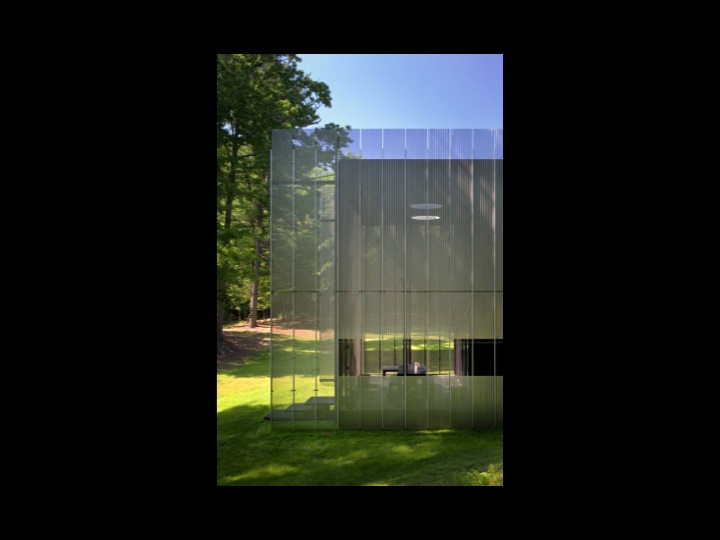
TP: And, there the edges get blurred, but also, as you see, there at the bottom, this screen — being this ventricular stainless steel — absorbed the light of the sky, the light of the moment — the grass and trees — kind of absorbed that into the house. We also wanted these to be environmental screens and the dimension between the stainless steel and the actual weather barrier is about 6 inches. These screens face east and west — the screen heats up and that heat is then allowed to go up into the cavity of air behind it. Because this house is not air-conditioned — it is naturally ventilated — it serves as this protective layer to keep it cool in the summer.
MB: Was this the first time you installed this type of system?
TP: The first time for us that we had worked with this double-skin. This budget was extremely tight. We got all this stainless feel from Germany for ten thousand dollars. We did a lot of research. That little piece that runs up there is a very simple aluminum extrusion and that stainless steel is just riveted with a simple rivet gun. The entire interior is made out of apple and maple plywood.
A: What is the approximate square footage? And, how did you handle drainage?
TP: The square footage is approximately 2,500 sq feet. The roof is just a flat roof. The water goes down in the way any other roof is made. There is nothing elaborate about the construction. This weather wall is built like every other house in the Hudson Valley, and it has plywood on the other side.
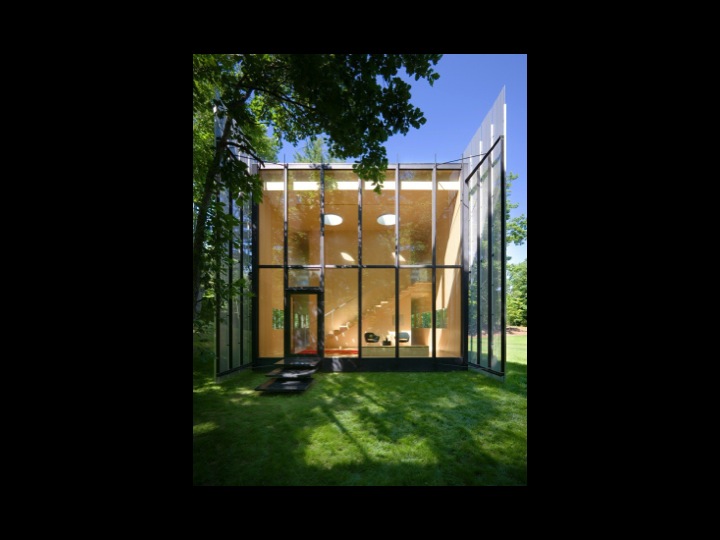
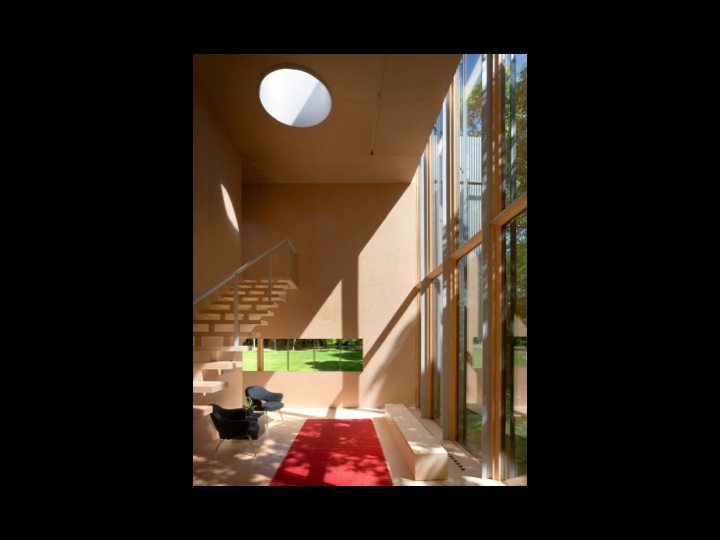
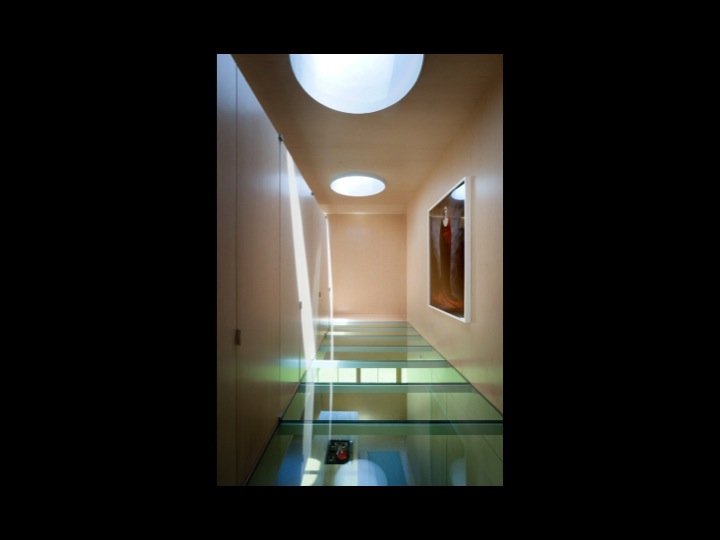
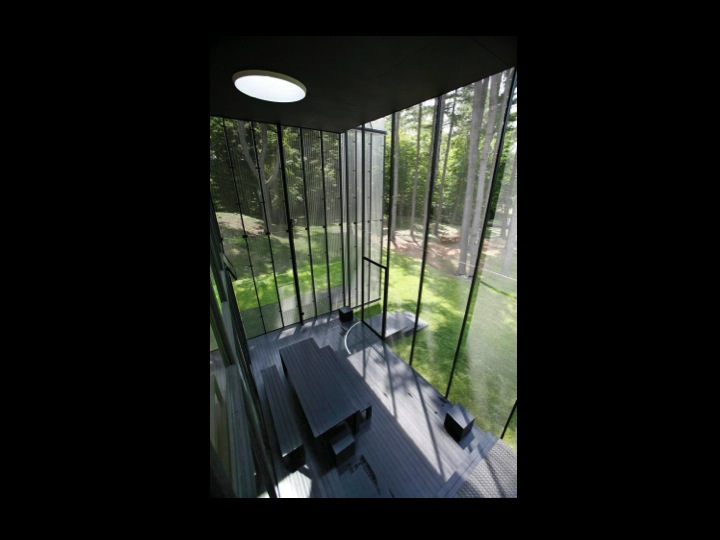
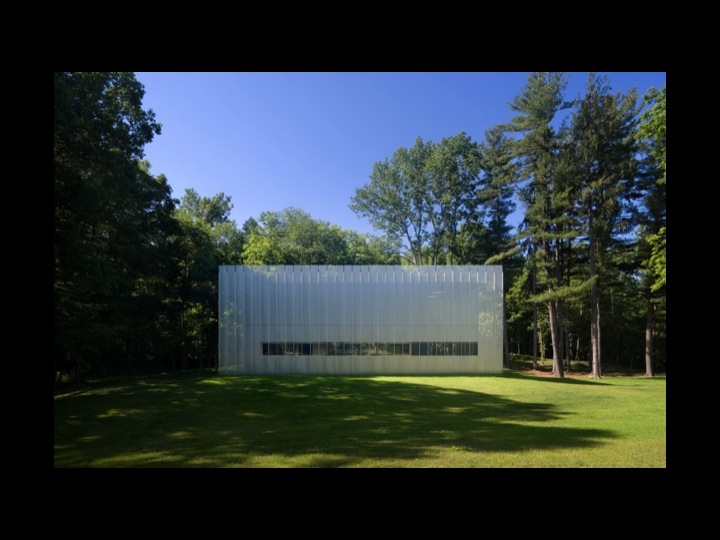
___________________________________________________________________________
Madison House, Wisconsin
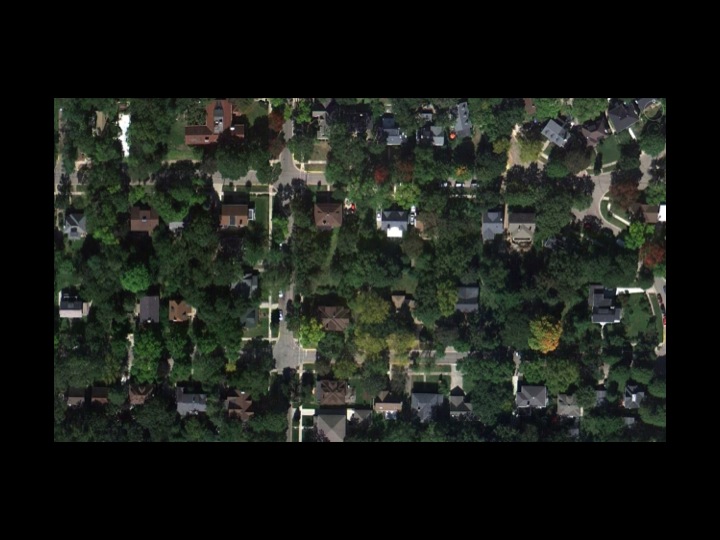
TP: This site in Madison, Wisconsin, happens to be actually two backyards that these two families got together and sold. This is an historic neighborhood. There is a Louis Sullivan house and a Frank Lloyd Wright house.

TP: I had just, oddly enough, come back from the University of Virginia [Thomas Jefferson]. We took a reclaimed brick that was on a factory — thirty, forty years ago — and we just take this wall and wind the wall around the site like a serpentine garden wall so that every room is articulated as a form. The windows are clipped on the facade — they stick off about one inch — they project. And, they are made of a slightly reflective glass, so that they reflect the landscape. The house is extremely small. You can stand in that gap, reach out and almost touch the two walls.
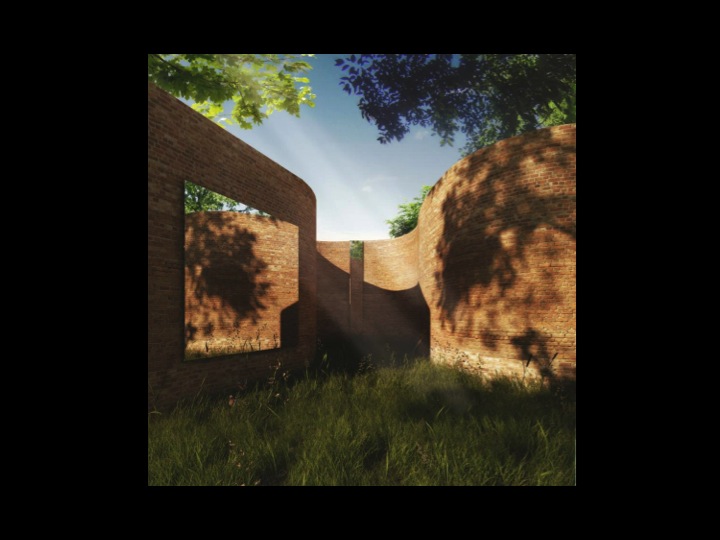
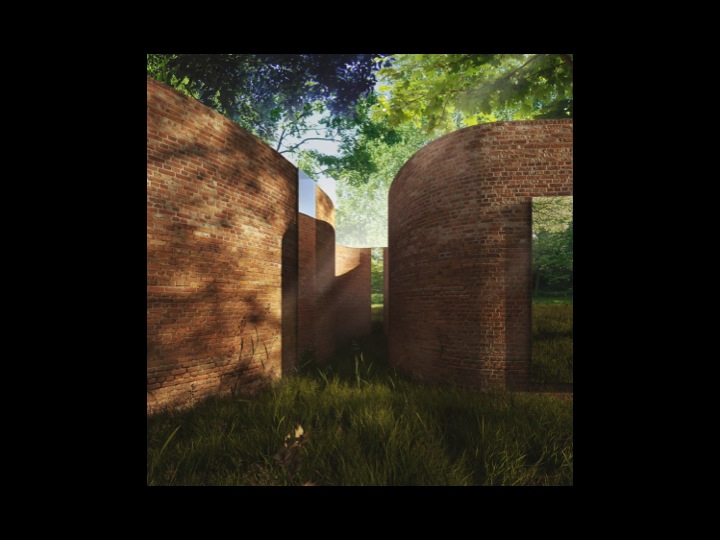
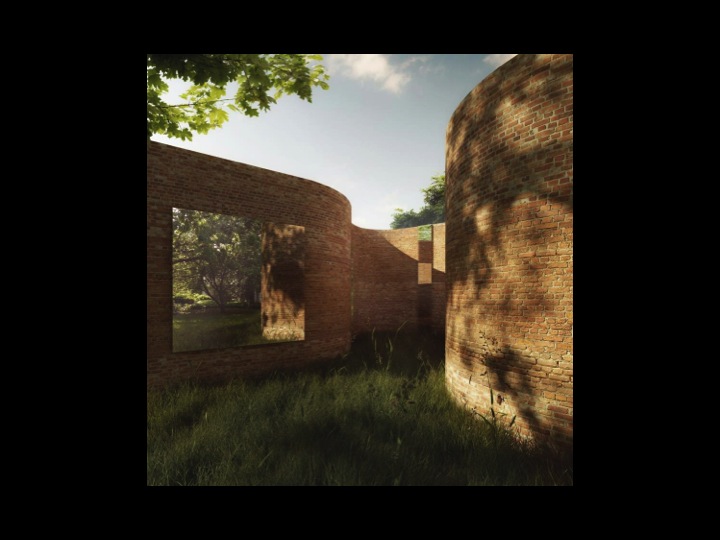


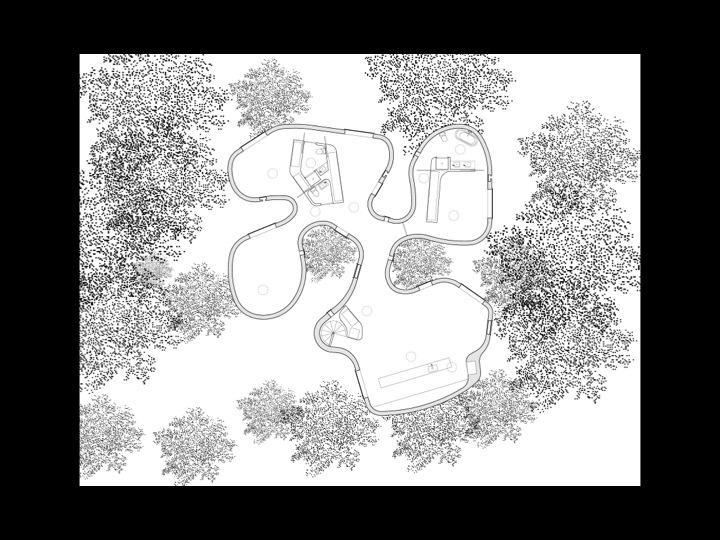
MB: It is really a remarkably different notion about what a house can be, but, in a way, it really captures its very essential ingredients. I noticed that you break your own rule at one point in the wall. You expand the thickness of the wall. You always adhere to your own rules very clearly [except] in this one instance, can you talk about it?

GS: We work on a lot of museums and met Brice Marden, the painter. For weeks, there was an obsession for pouring over Brice Marden paintings. And, Brice Marden is a master at breaking his own rules. So, the answer is that when you think you’ve got all the rules fixed, break them.
MB: A client of mine recently came to my office and said one of the most incredible things I’ve ever heard, ‘You now need to include a mistake.’
TP: I think that’s right. Look at this building. Herzog & de Meuron — that’s what they did here. Every time they look at it as broken rule that’s where the richness is.
GS: Who puts a column in the middle of an auditorium? [Ed Note: Column located in the seating area of the Lichtenstein Theater at the Parrish Art Museum.]
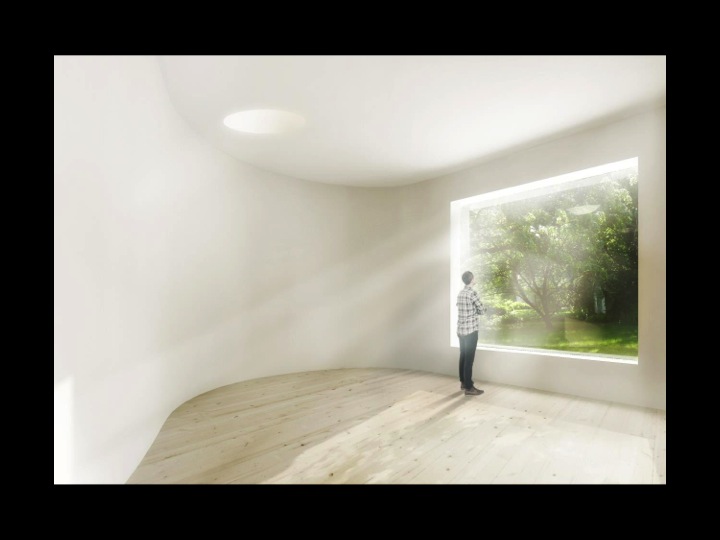
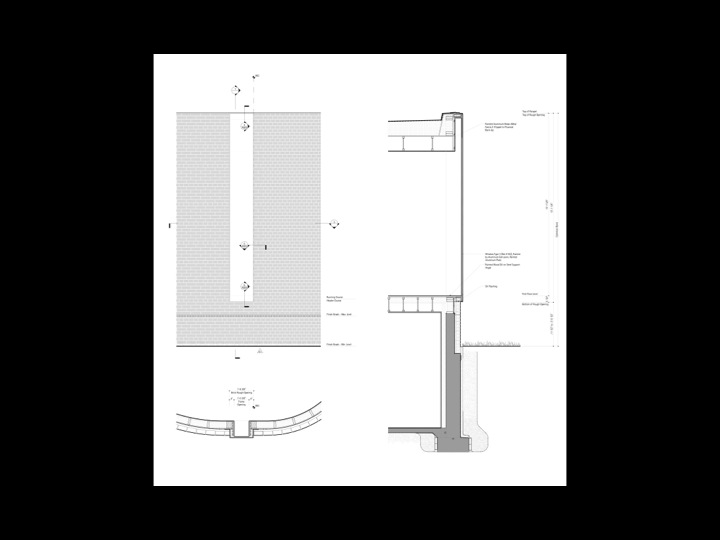
MB: A technical drawing for some members of this audience. I think the architects will appreciate how the window — there is no sill — is almost suspended, rather than sitting on the foundation.
TP: The wall here is made very traditionally — brick, air space, stud, insulation and sheetrock. The windows are made in a way one makes unitized panels– it’s structurally glazed and has a little angle that holds it in place. Just very, very traditionally done, but it projects off the outside wall by an inch and expresses its essence there.
MB: There’s no frame around it?
TP: There’s no frame around it, just pure sheetrock.
Audience: How do you keep the water from the underside of the window?
TP: The window actually goes in — there is a frame about six inches deep. It just goes into the house — the sealant is around the base the way a normal window would be caulked.

TP: These are my favorite shots. Look at this contractor — he is a master — look at those forms! The sill plates that sit on top of the wall are just perfectly made. We were so, so fortunate to have somebody who took this kind of care and thoughtfulness to make these forms.
__________________________________________________________________________
North Carolina Museum of Art, Raleigh
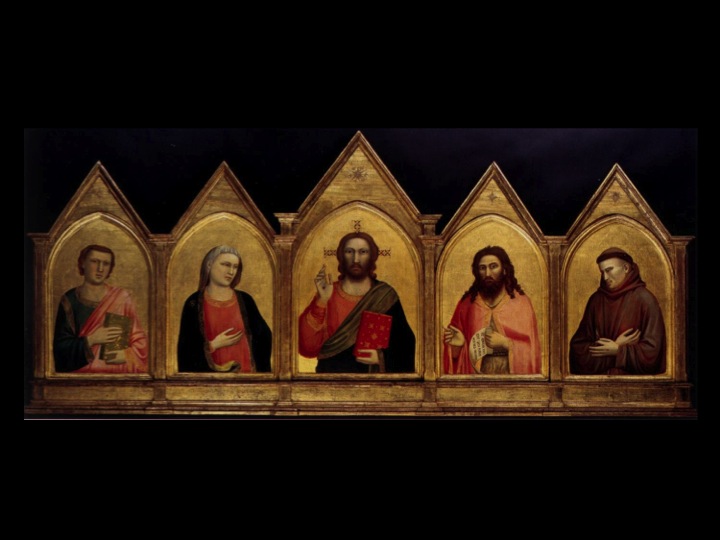
GS: This painting was shown in a dark space like this [Lichtenstein Theater]. We challenged the entire staff (at the North Carolina Museum of Art) when we said that we wanted to put all of the art under daylight.
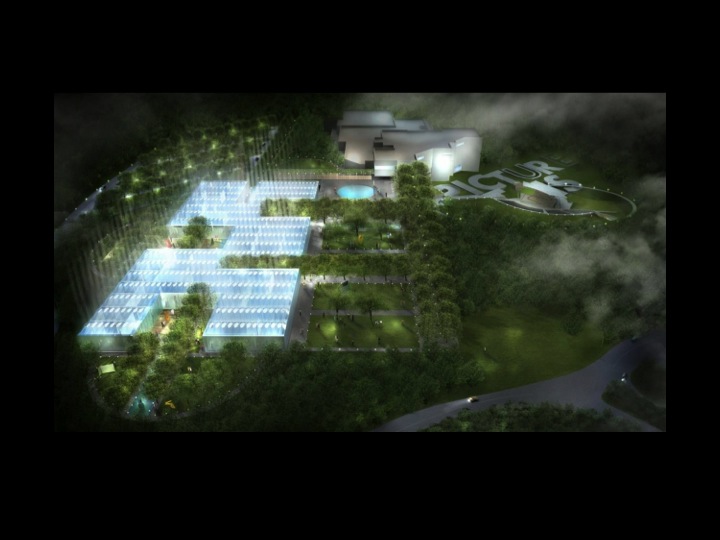
GS: After many, many schemes we came up with a single story building that has 360 skylights. You can turn off all the lights. We put these works of art in this very, very luminous space.
Audience: That natural light — doesn’t it hurt works on paper?
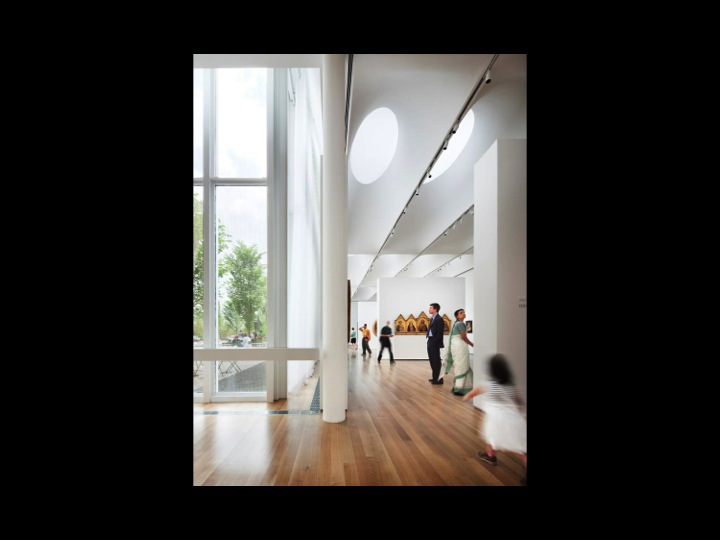
GS: Yes, it would. No, absolutely — if you leave those works exposed to full daylight, they will absolutely deteriorate. We have skylights that are tuned with louvers on the outside to prevent direct light from coming in. There are a series of layers in this very simple looking oculus that include fabric and light defusing layers, so you can calculate the exact foot candles.

GS: We did a lot of these precedent studies and explained to our clients that we are not doing this for the first time. In fact, a lot of the works they are showing — the Dutch Masters — they were painted in daylight and shown in daylight. We kind of had to educate ourselves and our clients.
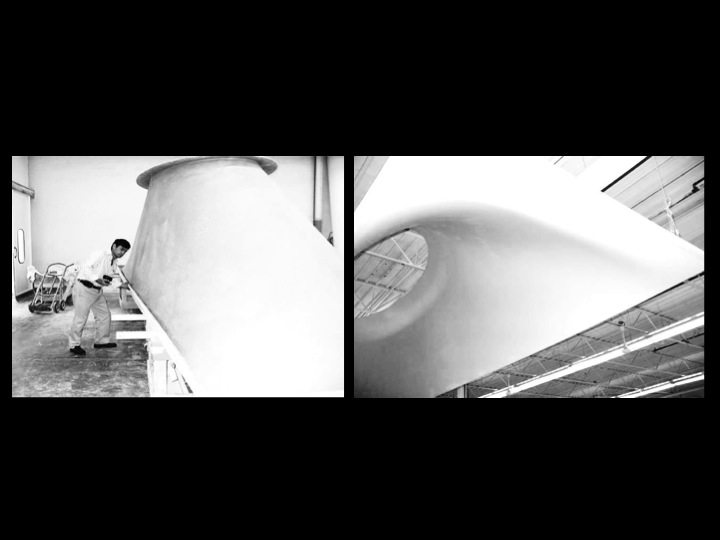
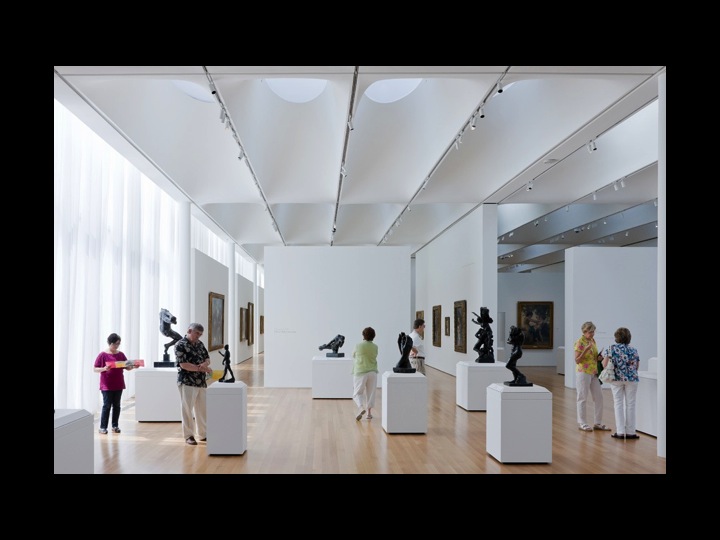

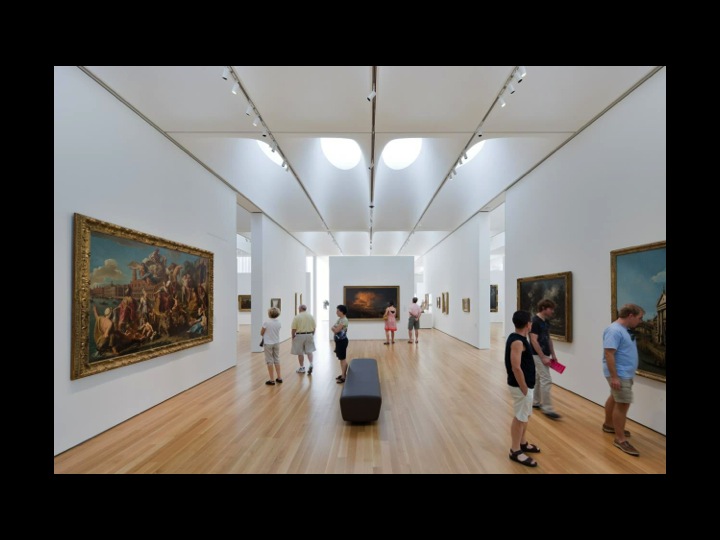
GS: We worked really hard to get rid of the devices that you see in a museum. Got the air-conditioner to work through the slots on the top and bottom of the walls.

Audience: Who did the artwork on the left?
TP: That was Patrick Dougherty. These are sticks from the site. It is an incredible work. I think it actually grounds the museum — it even gets richer when you are there — you see the quality. It is just an extraordinary work.


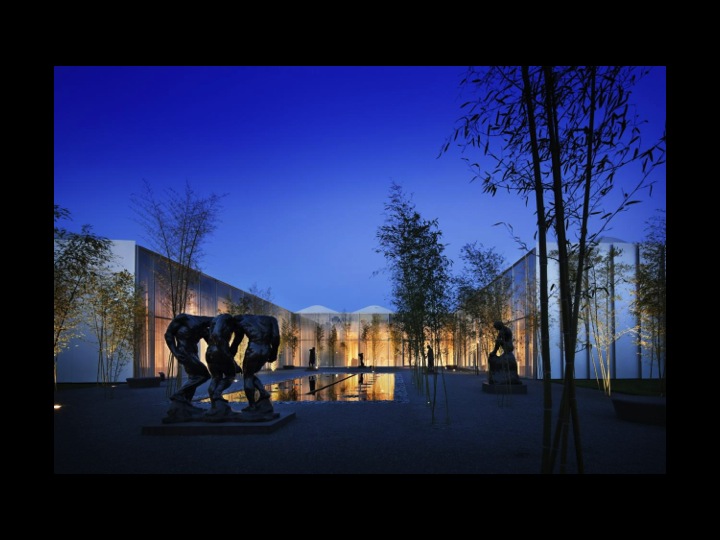
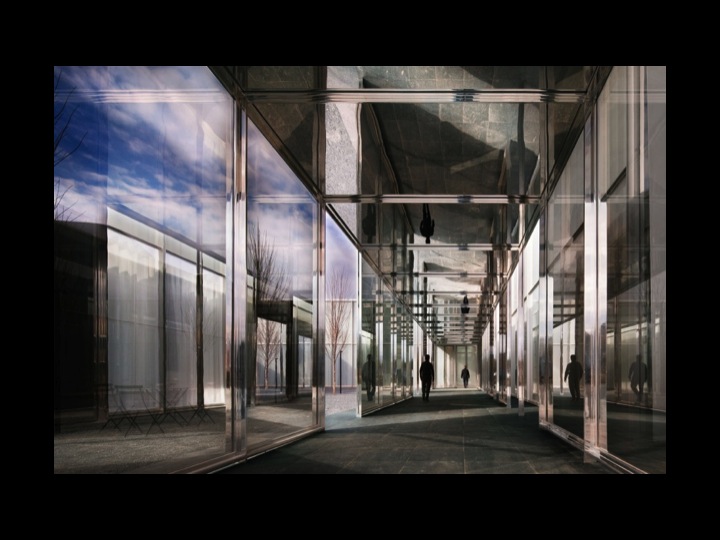
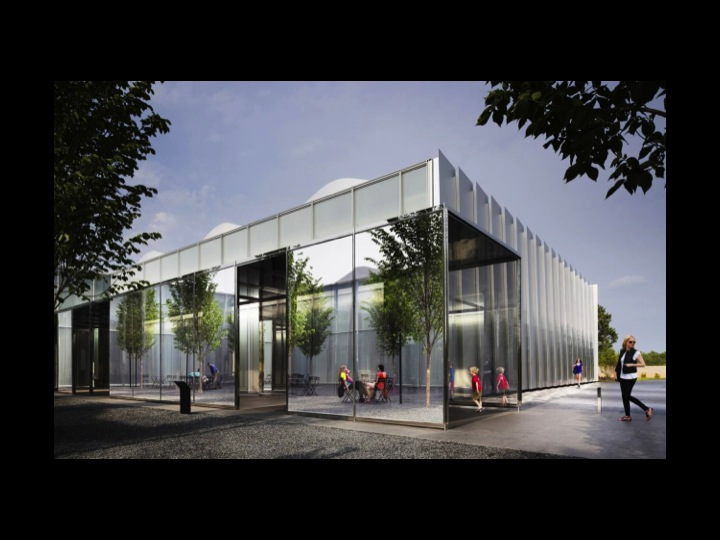
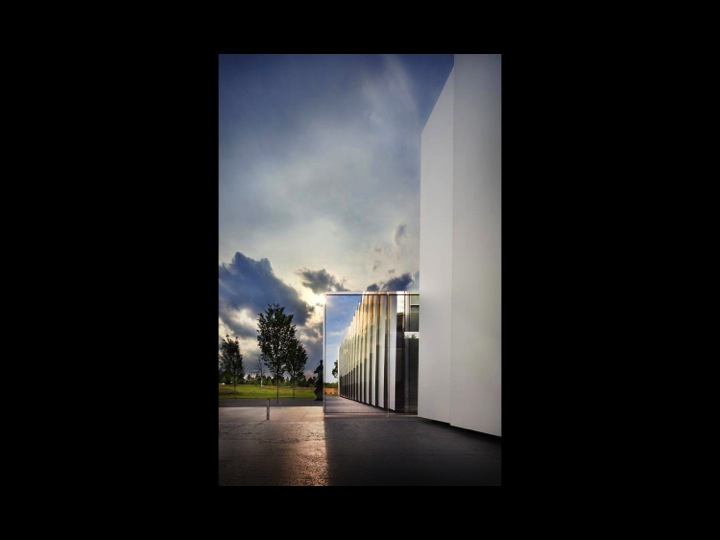
GS: We talk about the relationship to nature. This building is a good example. We talk about resistance relative to the site. These exteriors, while they actually reflect the site in a literal way, they also do not do that all the time in the same way. You cannot try to emulate or imitate what is going on. Nature is impossible to chase. I think by respecting materials that you put in nature and by resisting slightly the context, you actually enrich both the building and the surround around it.
MB: And it lets you see nature through its filter.
GS: You give it a new horizon.
___________________________________________________________________________
Corning Museum of Glass, Corning, New York
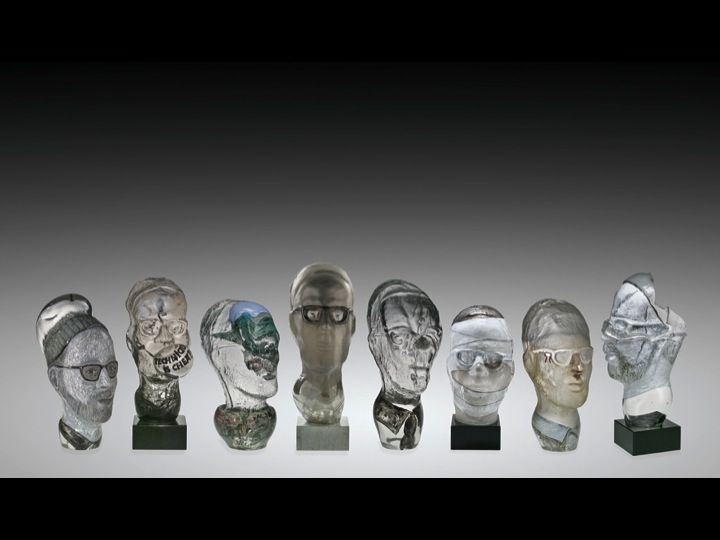
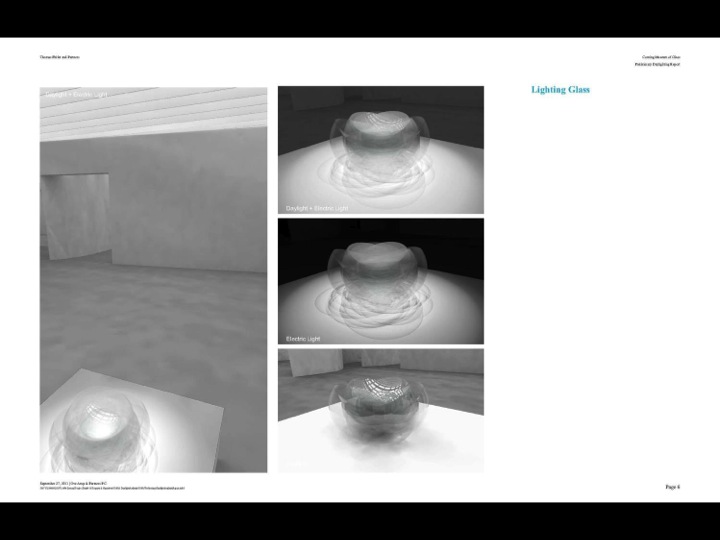
GS: This is the Corning Museum of Glass, which is under construction now. 100,000 sq ft, with 26,000 square feet of galleries that are entirely day lit. We did lots of studies on what glass likes — fortunately for us, it likes a lot of light.
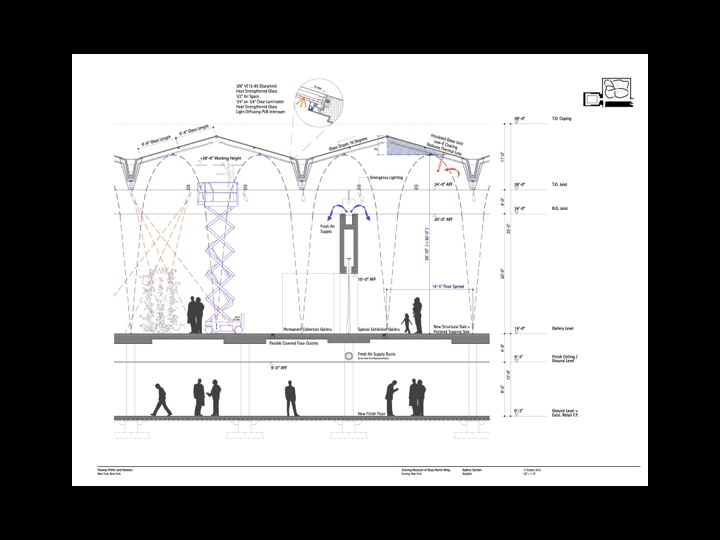
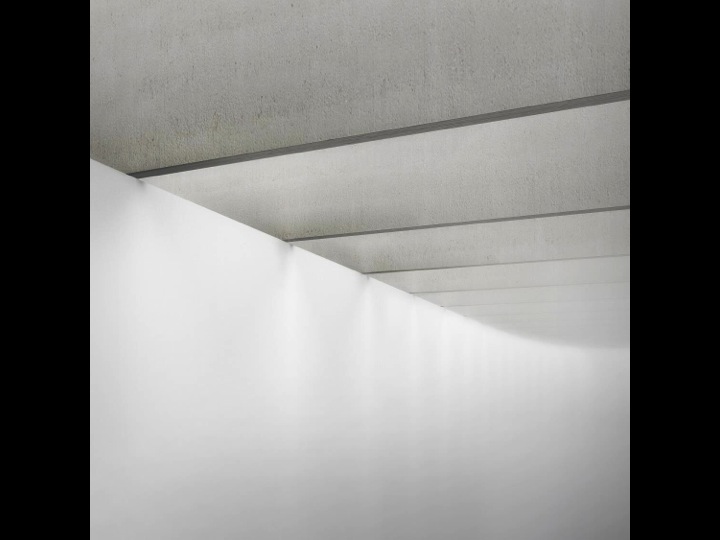
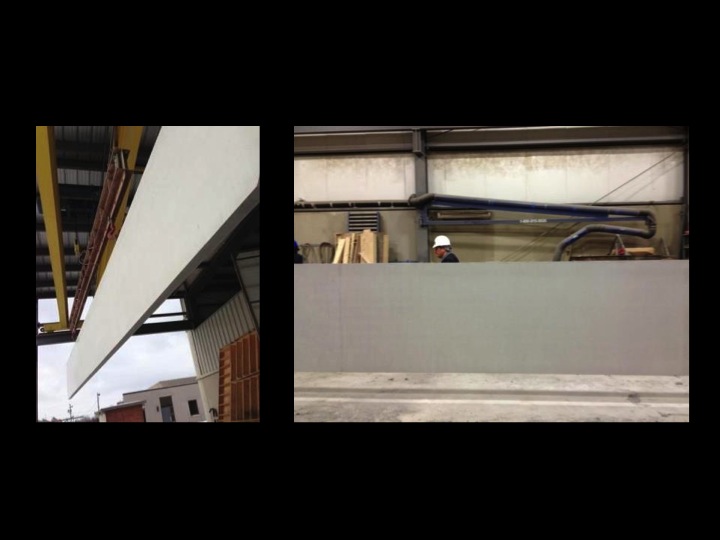
GS: We were able to put a skylight over the entire building. Then build up a series of beams that are 4′ deep, 3-1/2 inches thick, made of concrete that actually baffle the light and gently push it down to the floor. Glass, mostly sculptural objects, likes a top light, likes an intense light. The beams, being made in Canada, are all different sizes — the longest is 60 feet. We are working with Guy Nordenson’s office on this project.
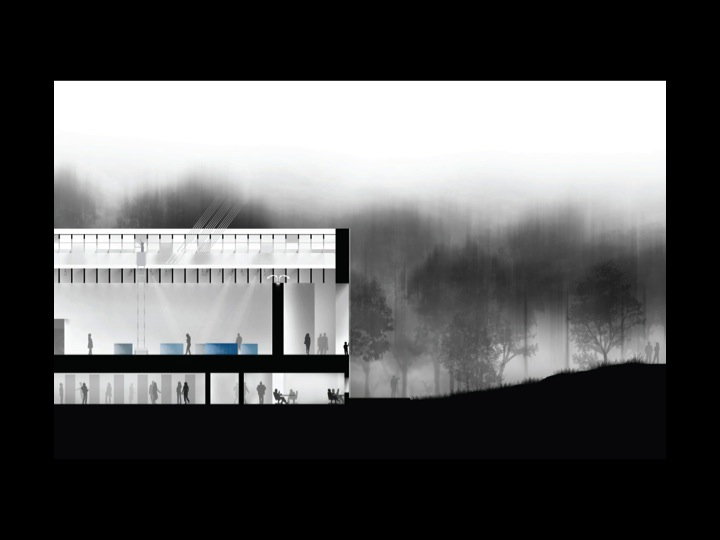
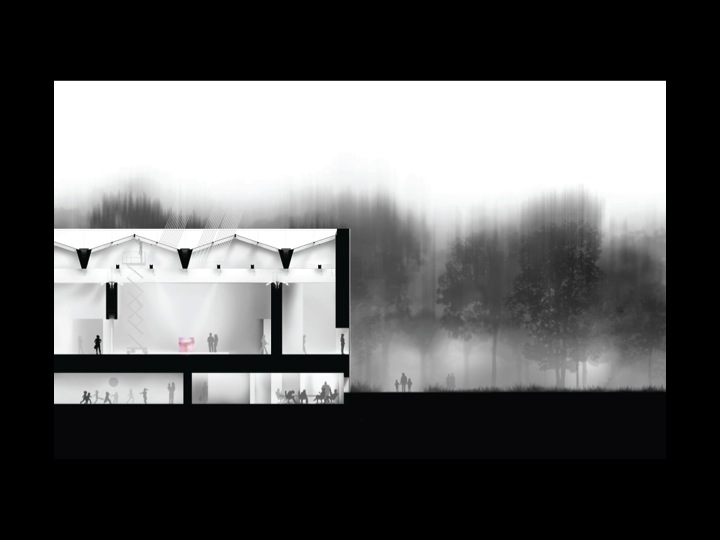
GS: These are the beams — the light comes through — it’s reflected down onto the collections. And it looks out onto a green that we made for the museum.

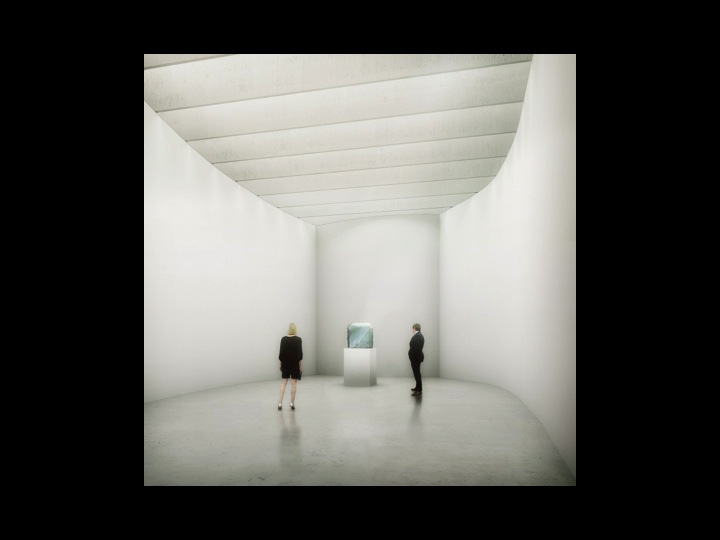
GS: The other feature is a series of curved, serpentine walls that support these beams. These are the spaces in rendering form. The walls are up — the concrete has been poured to the top. The beams are coming to the site.
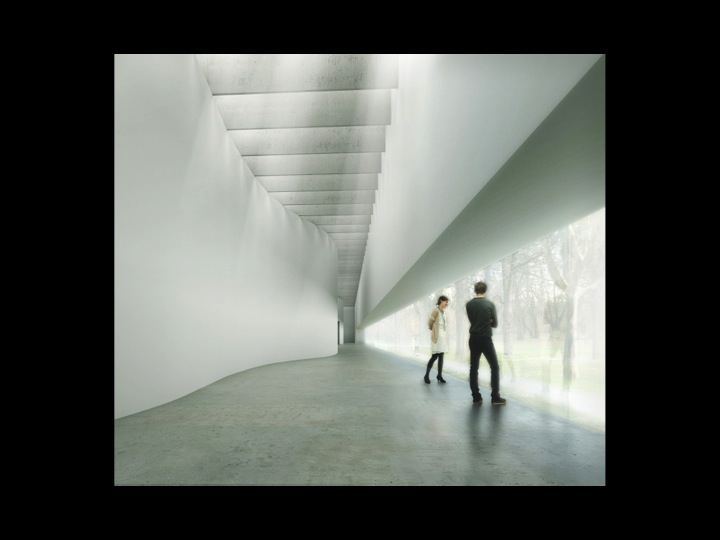
GS: This is a view of what we call the porch.
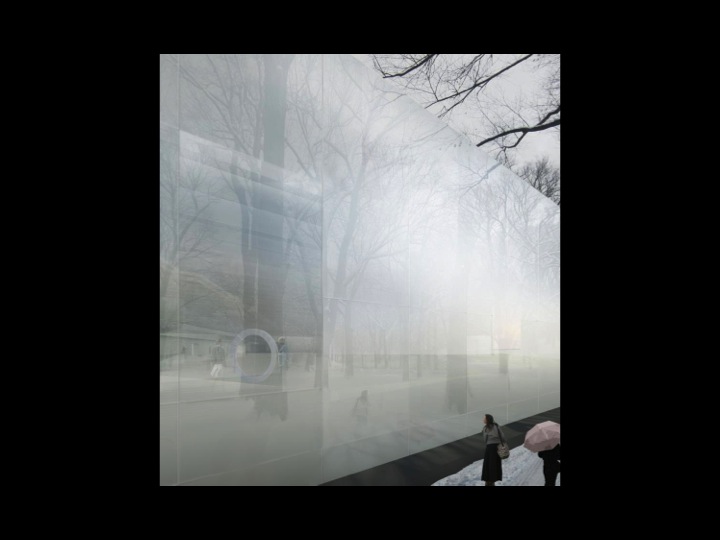
GS: This is the exterior of the building. Again this notion of resistance to the site — a beautifully perceived big white box. This museum is the result of a lot of additions. Each time an architect has arrived at the site, he has done a kind of exuberant addition. We thought it would be interesting if we made something that is a little quieter.

GS: The one to the left is the gallery building — contemporary glass gallery. The one to the right is the old Steuben Glass factory building, which we are turning into a 500-seat theater. They will actually show live demonstrations of glass blowing in that theater.
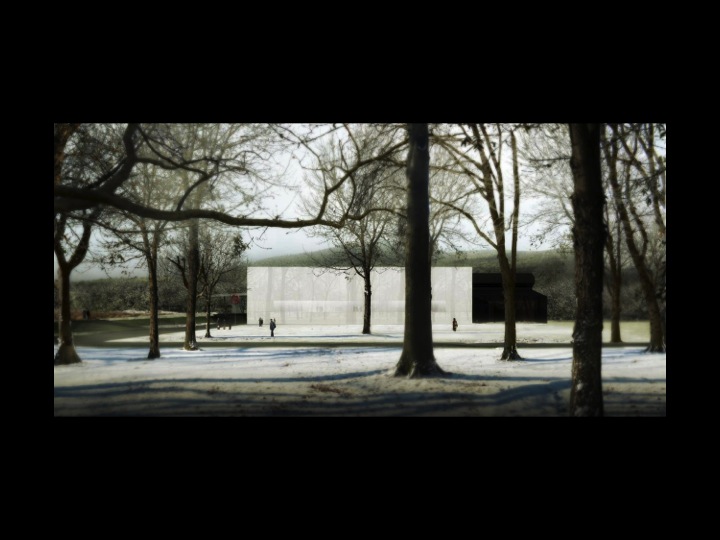

____________________________________________________________________________
Glenstone, Potomac, Maryland
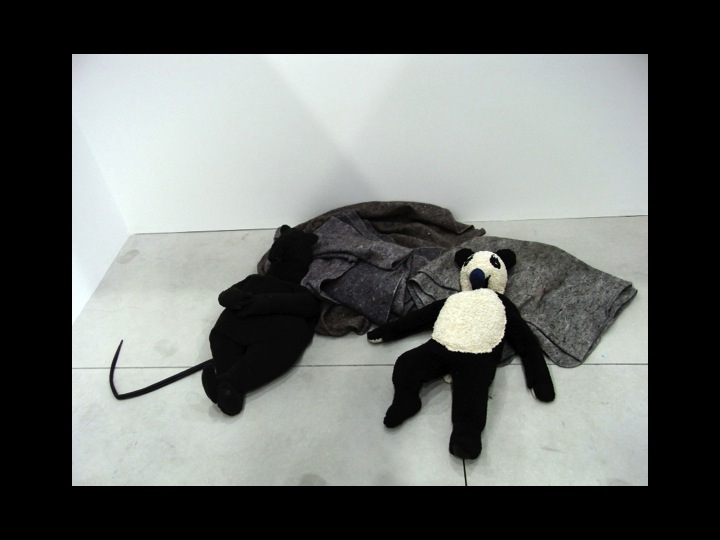
Panda & the Rat –– Rat and Bear by Peter Fischli & David Weiss
GS: This is the Glenstone Project, which I think is the most serious piece of architecture that I have ever encountered that houses some of the wackiest sculpture and art that I have ever seen. Like this — this is the Panda & the Rat.

GS: This is a competition that we won three years ago. This is the site in Potomac, Maryland. It is rolling, horse country, 225 acres, half an hour outside the city [Washington, D.C.].
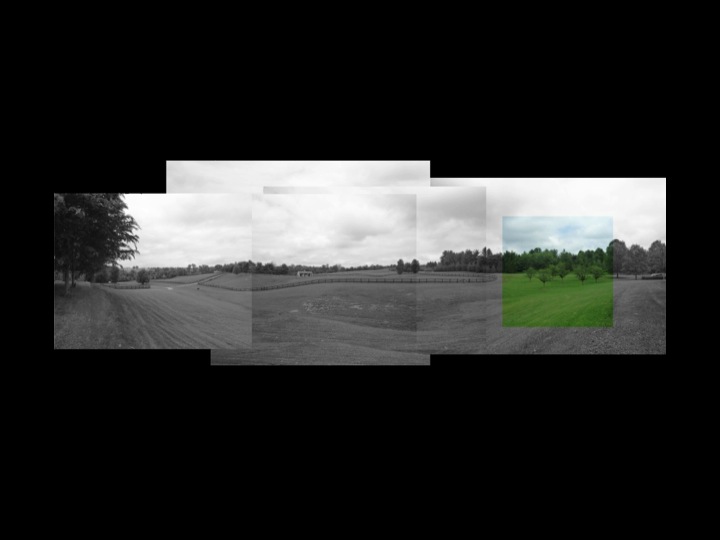
GS: We looked around this site and started noticing that there are these particular locations that kind of come out of this very soft landscape.
TP: This was one of the first images that we made. Actually someone in our office put these together and put a square on it, for some reason, and turned it green.
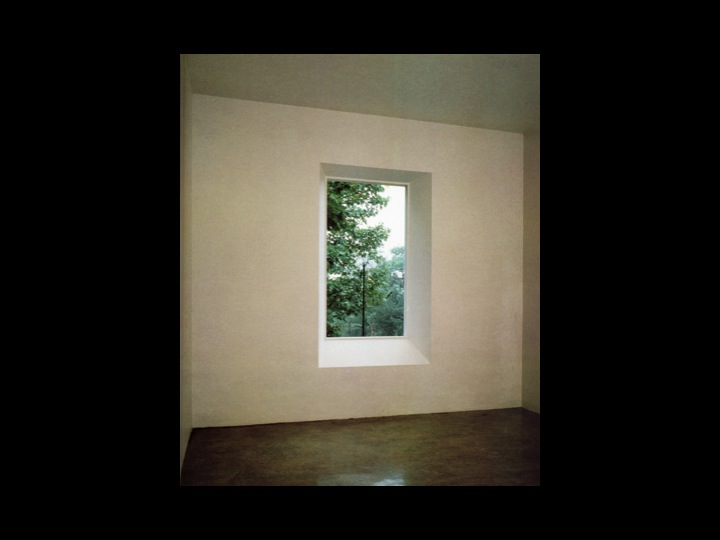
Bob Irwin at La Jolla Museum
TP: It reminded us of this. Bob Irwin was given this room in La Jolla Museum — you could do anything in this room you wanted to do. Bob said that he wanted to cut a hole in the wall. And he battered the wall. And this is the frame view of nature, and this is kind of where the project started.
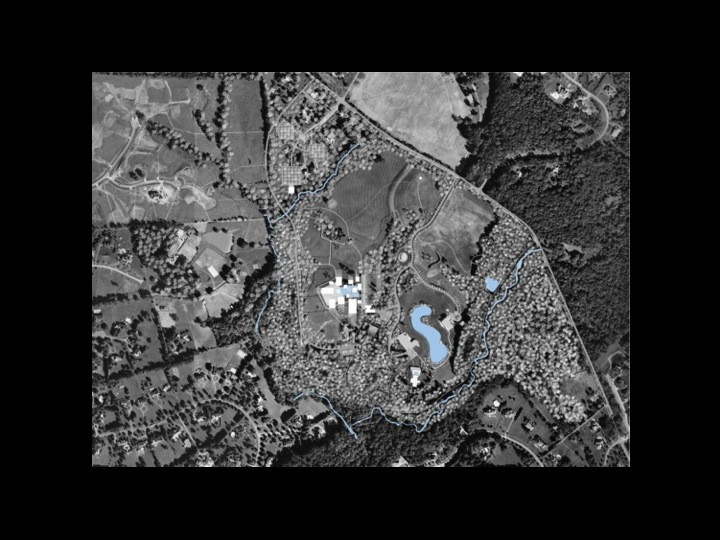
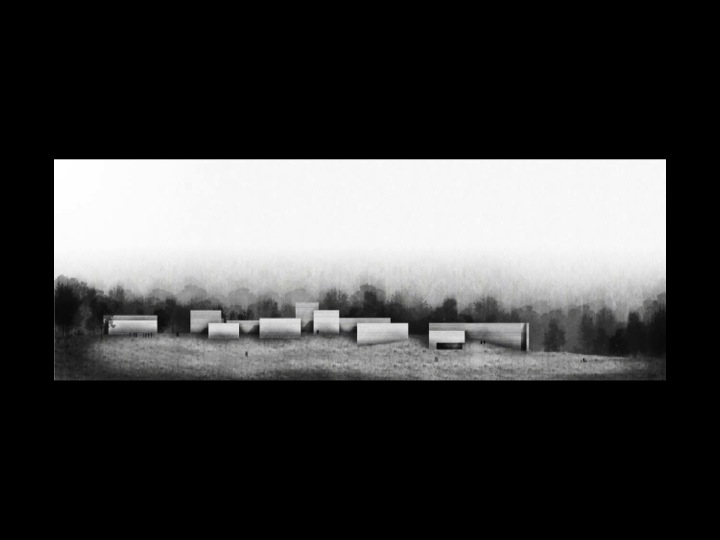
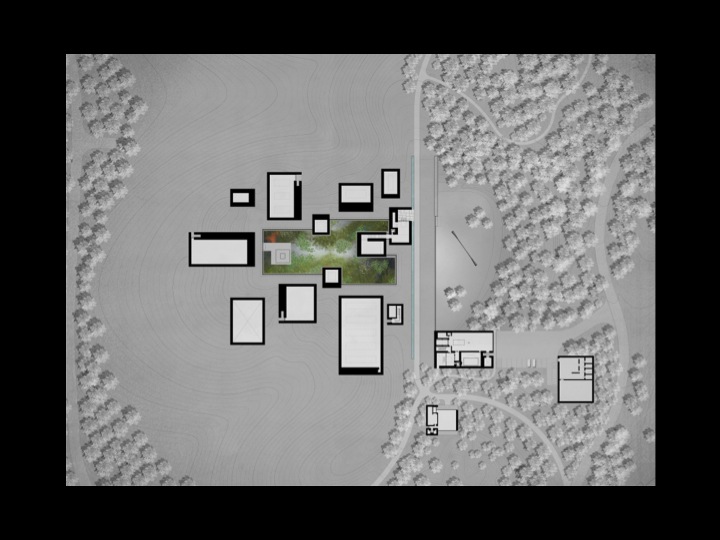
TP: This is the site plan. You arrive and park in the middle. As you walk through the meadow, this is what you encounter. You can see the assemblage of buildings around an existing land form there. We are putting these buildings in this existing land form. And each one of these buildings accommodates a different artist, but it is one artist, except for this larger building, the changing gallery . Every one of of these has either one piece of art or a few works by the same artist.

TP: Ryoan-ji is there. It was the inspiration for this planted garden — a place of calm, repose and silence — where all you see is the sky and nature above.
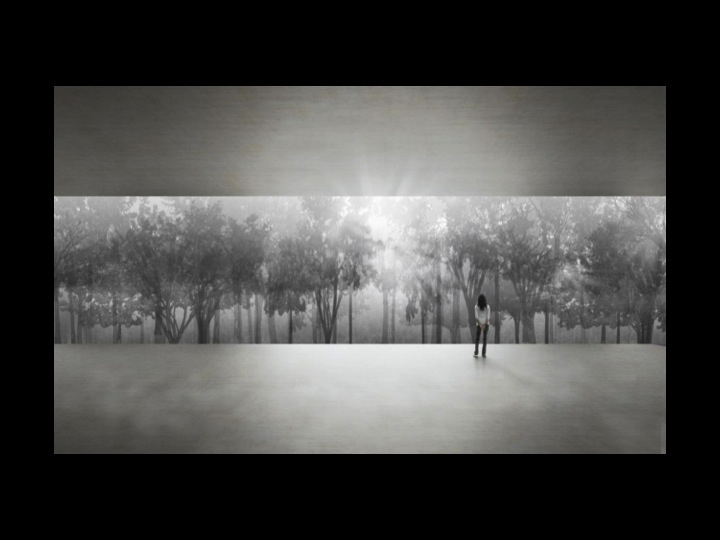
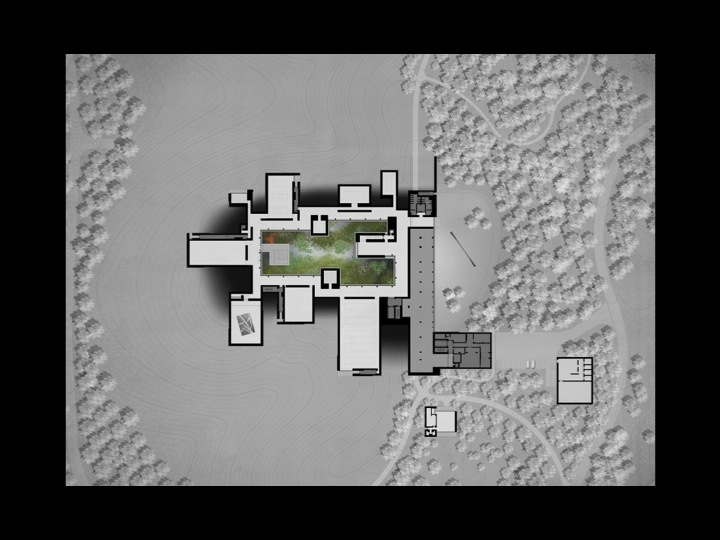
TP: Here there is a planted pool on the scale of Ryoan-ji. And, you come there without the distraction of a bigger landscape. And, you have a sense of calm, or you go [into the museum] and have another experience.

MB: This is a remarkable diagram. It shows how a building that seems seemingly random is, in fact, not. I think there is probably even a grid system that underlies…
TP: There is a rigorous grid system. There was a lot of study that went in here to understand how you move through passages guided by light and having a slowly unfolding experience.

TP: This is Carl Andre, taking something very simple and ordinary and making it special by ordering it.
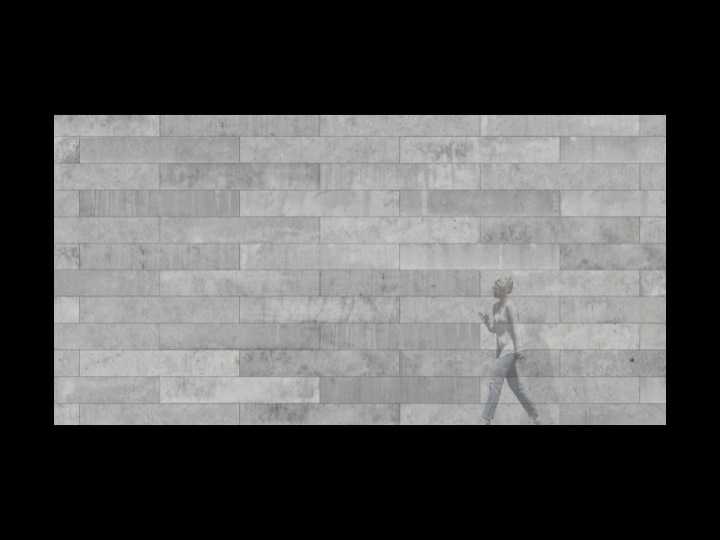
TP: The whole building is made out of these stacked concrete blocks. 6′ long,1′ high and 1′ deep, and load bearing — in some cases 60′ tall. Made out of absolutely grey cement, with no additives. They get this kind of variety because they are poured over a two year time period, 18,000 blocks, changing humidity, changing temperature, slight change in cement, change slightly in water, bleeding them out — you will get this kind of texture. What we are after here is an authenticity of this material.
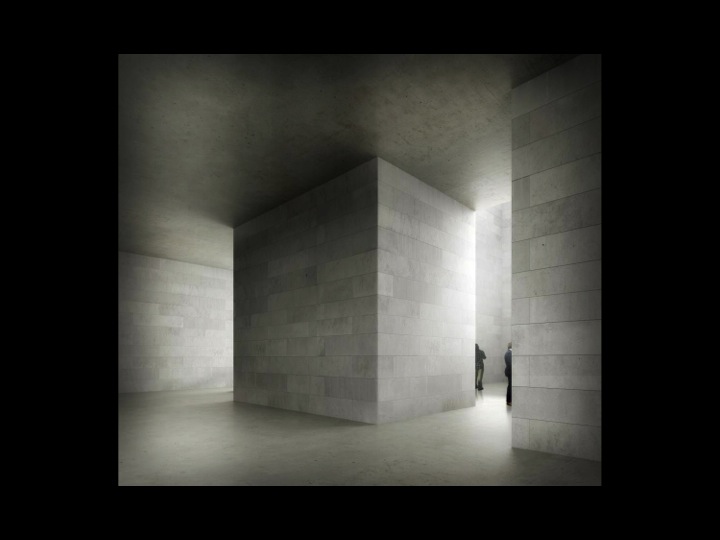
MB: Concrete blocks are both inside and outside? And is there insulation between the two layers of blocks?
TP: Yes, there is a concrete wall, there is an air space, and the blocks that stack up on the outside and the inside. But inside the art spaces, those are plaster. You can see what is beginning to happen here — the way you move around corners guided by light. A kind of shifting of buildings starting to happen initially, because we wanted this kind of unfolding experience as you move around.
Audience: Do you have to exit one building to get into another?
TP: No, it is enclosed. There is an enclosed passage that you walk through and look out at the pool.
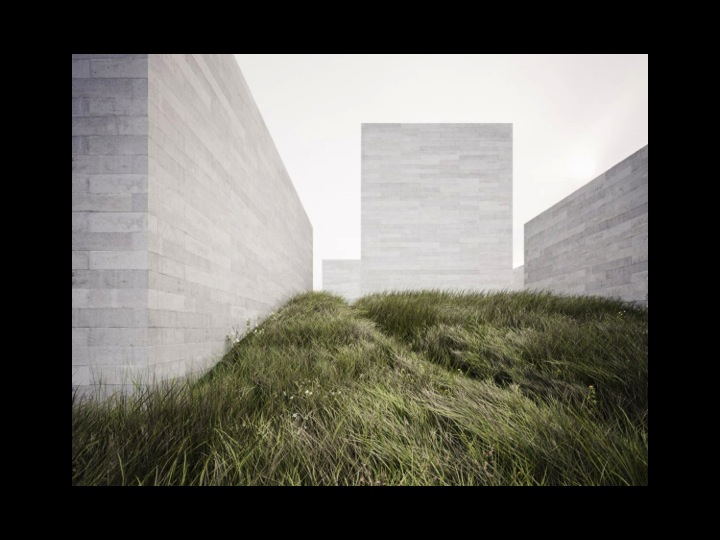
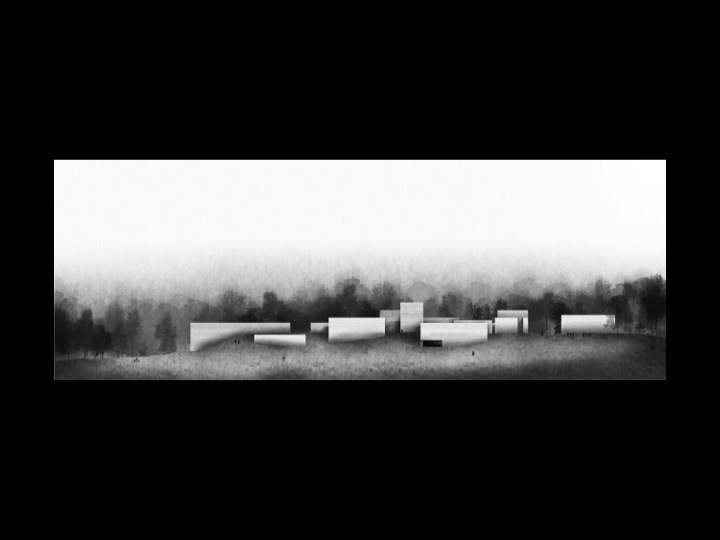

TP: One of the things that we love to do is to be very, very close to our clients. I think this building represents their spirit here — it is a private foundation, run by a husband and wife, founded by them. I think their spirit guided us — they’re quiet, they’re very thoughtful people. I think that quietness and that silence began to influence the kind of experience that we wanted to have here. I think there was that wonderfully symbiotic relationship between architect and the people who wanted to build. This is as much theirs as ours. This was one of the first drawings we made before we did much of anything. These very simple, almost Renaissance cubic light spaces, where we just cut a hole in the ceiling to let light in. We wanted these kind of Roman spaces — kind of simple, heavy architecture to set out on the landscape.
MB: The way the spaces are top lit, of course, continues what you had done in the past, but, in the solidity of the walls, the materials used, it is quite a departure. When they came to you, were they expecting to see lots of transparency and glass and reflectivity that you had explored in previous projects?
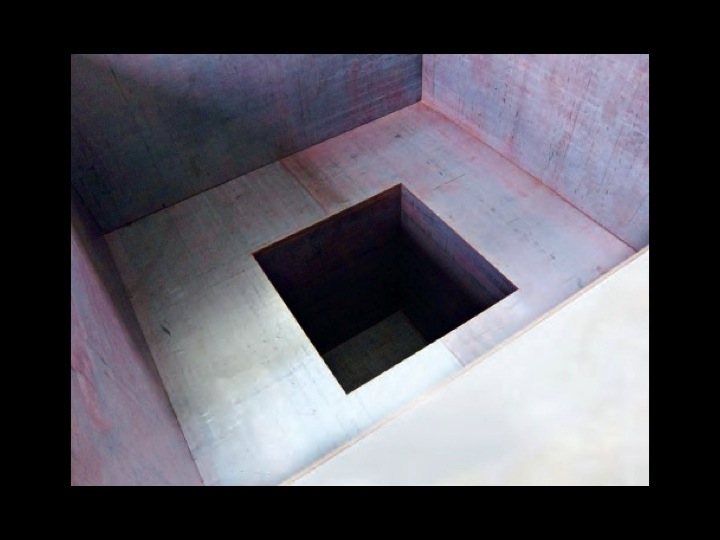
Martin Heizer’s North, East, South, West
TP: I think they might have expected that. It is a little hard to know. Very quickly, I think, we were there with something that was heavy and very much about the experience. We focused for the longest time on what the architecture was — the experience of the architecture and the experience of daylight. And the works themselves, and the artists that these buildings were going to contain. Those came together long before the character of the architecture. It was works like this — Michael Heizer’s North, East, South, West — this was our model for the ceilings in the building. It was kind of just this void for light.
MP: In your office, I saw large scale models of the rooms. I think you did those to study the quality of light.
TP: We did that to study the quality of light, the scale of the space, the materiality. All of that. Each room has a different character. It has a different light character, different size and proportion to the works.
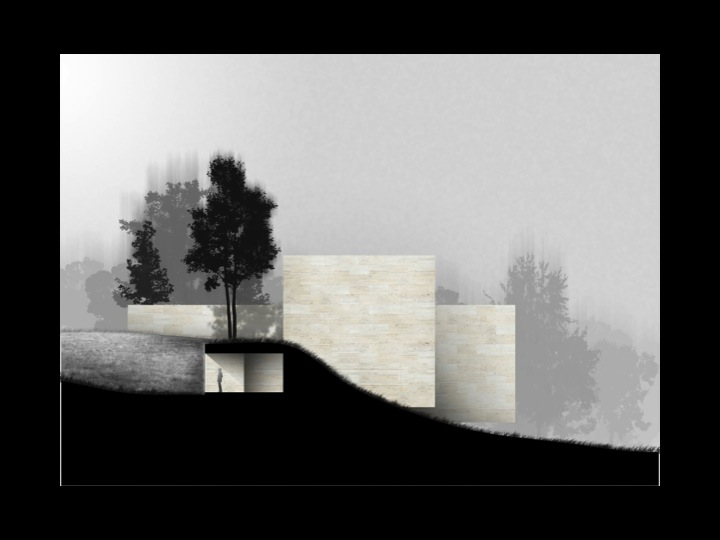
GS: It is about fitting those pieces. We really did start from this dialogue about the works. For us, it was very clear — the artwork is extremely powerful and often very hard to understand. And, you have got to clear your mind between each piece. That was something that came very quickly and resulted in a different kind of response.
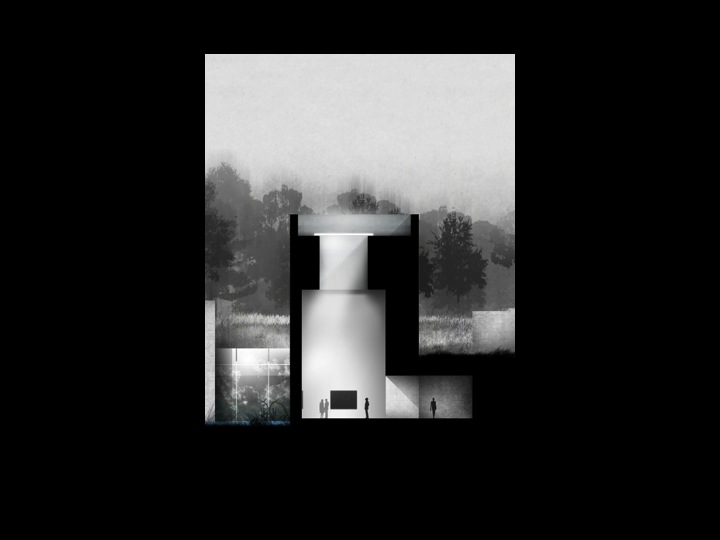
TP: It’s hard to work on a museum like this without thinking about the Louisiana Museum in Denmark, where the buildings are spread apart, but you go from experience, to a view of the garden, to a passage and then another experience. You get glimpses of the landscape. And I think that building in particular, although it doesn’t look anything like that, the idea that you have an experience, then take a pause, a kind of metabolic change there, a kind of rhythm, a kind of musical rhythm. We also looked at spaces like Ryoan-ji and Japanese temples — having that kind of silence. And, we talked about this with our clients. This was a very cooperative and supportive relationship.
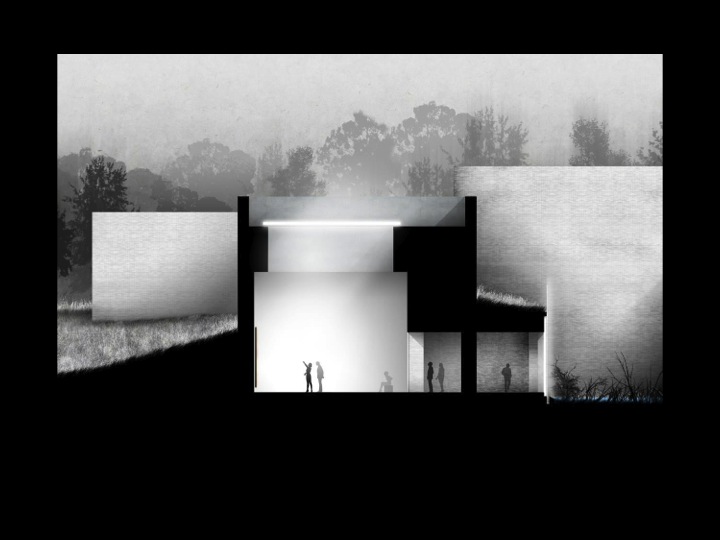
GS: There are thousands of renderings and hundreds and hundreds of technical overlays between this building and the Louisiana building. We took a trip with our clients, but we also — in the finding of this building — we studied. I have never, ever been in an office where it is such a rigorous attitude. This is Tom, really, an attitude about how to work, and it’s just relentless.
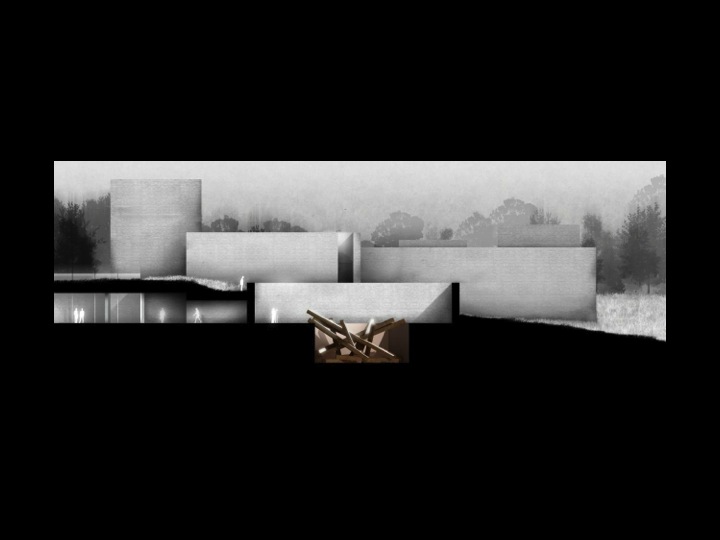
TP: I think what we were trying to find — is that silence. You know Lou Kahn talked about silence and light. The kind of silence you find in experience — I think that kind of attitude was extremely important to us. But that, I think, came as a hint from our clients, who have that kind of silence there. And, you counter that with these exuberant works — the Panda and the Rat — this contemporary art — it is kind of heavy. We were trying to find a counter to that, so that there is a silence in the architecture, and, supporting that, are these extraordinary works of our time.
GS: They also asked us to make a building that would last for one hundred years. In this day and age — that kind of conversation I have never had with a client. When they began to say what would it take to make this building last one hundred years, the conversations changed. They go toward a different place. And, it’s a combination of the art being hard to understand and also a building that goes beyond a formal exercise or a technologically simple answer — as much as anything that rooting and grounding the project. And, so you keep going back and asking, formally and tectonically, how do we make this thing that is going to be here for a long, long time? And, what does it mean to make a move in that very, very delicate terrain of one hundred years?
Audience: What is that artwork?
TP: This is Michael Heizer — who doesn’t learn something from him?
A: Is there an existing museum on that property now?
TP: There’s a little museum that was designed by Charles Gwathmey. It is on the other side of this big stand of trees. This project sits in a huge open field.
Audience: Was James Turrell an influence at all? They look like Skyspace.
TP: I think James Turrell started when he just cut a hole in the ceiling. He got a little frustrated, and he didn’t know what to do, and he cut a hole in the ceiling of a building, and light came in. It is like the Pantheon. That is the way you feel in Rome — you walk into an old building there, and there is just a hole in the ceiling, and you watch the light. When we were in Rome, we were there almost every day. The Pantheon — we were just mesmerized by the way the light and nature come in and make a work of architecture.
MB: When this building is finished, it will become a big attraction. You will see huge crowds going through it, and I wonder how you project that through this space that has a sense of austerity and richness, at the same time, and a quiet…
GS: This client is extremely disciplined. They have thought about alot of this. When they came to us and said we love this and want to do it, they also had already figured out how to do the ticketing. They are incredible people. They have thought about a lot of things. They are now building a staff, interviewing each person on that staff. They have a mission statement, and it includes a rich marriage between the landscape, the architecture and the art. And they will never, ever, give up on that.
TP: They only want about 20 to 30 people inside the building at one time.Very, very quiet. We removed the books and we removed the cafe from the building. The only thing in this little cluster, in the little village of buildings, are the works — it is all about the works. This is a kind of living testament to their devotion to this silence.
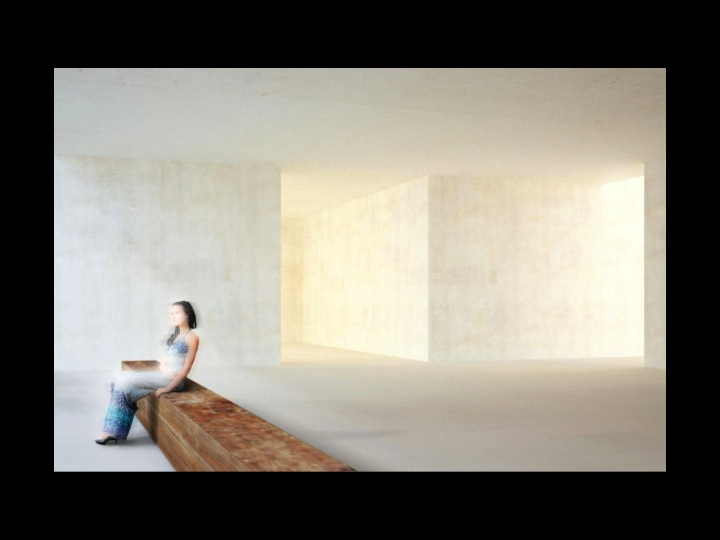
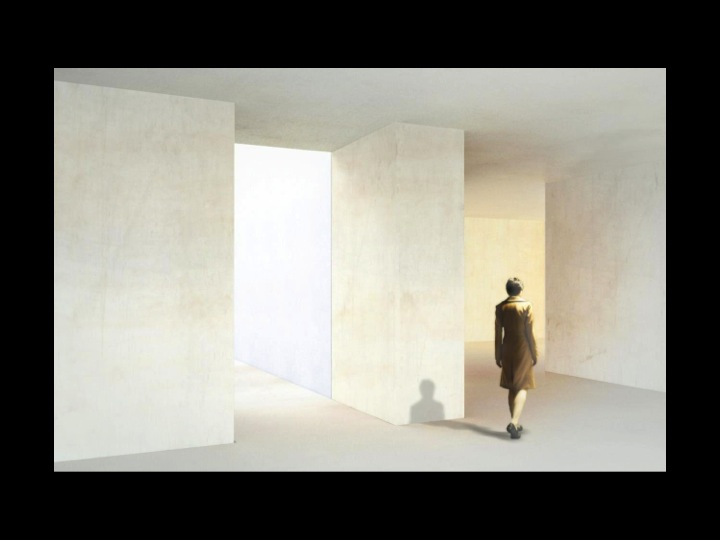
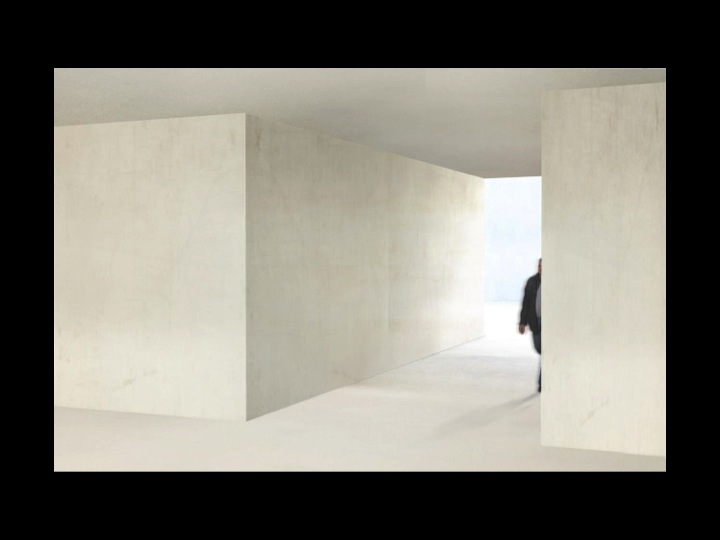
TP: These were some of the early, early renderings we made about this experience in the passage as you move around, kind of guided by light. These were made when we were shifting the buildings around and trying to gauge this kind of notion of how you approach this passage into these rooms.
GS: You [MB] had asked me to put diagrams in the project slides. We diagram buildings just like everybody else does, but this is really the diagram for us. It’s testing through the visual — these kinds of studies.
Audience: There is no pencil to paper at all? It starts out with those?
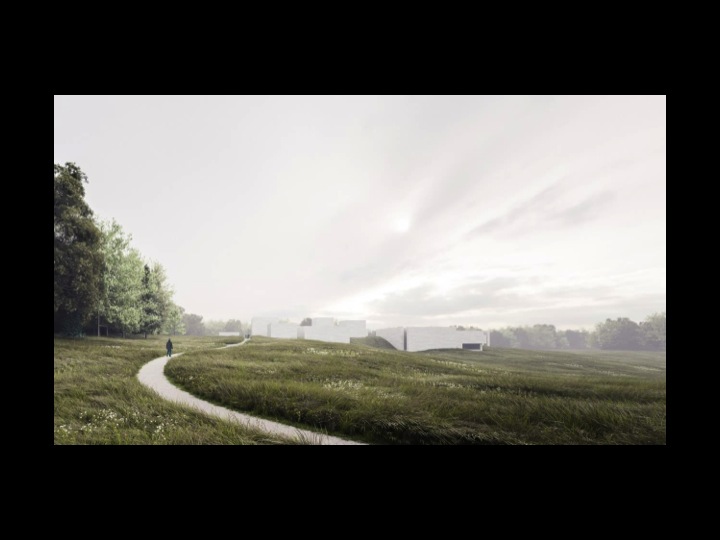
TP: I grew up in a generation where I had a t-square, but not any more. We have learned in our office how to work together using the computer. We all sit around the table, we work together, we doodle around. We have tracing paper, but we all work together. None of us sits back there and makes a drawing and tosses it over to the drafting department to get it drawn. It is all done in a very cooperative way — where things are shared.
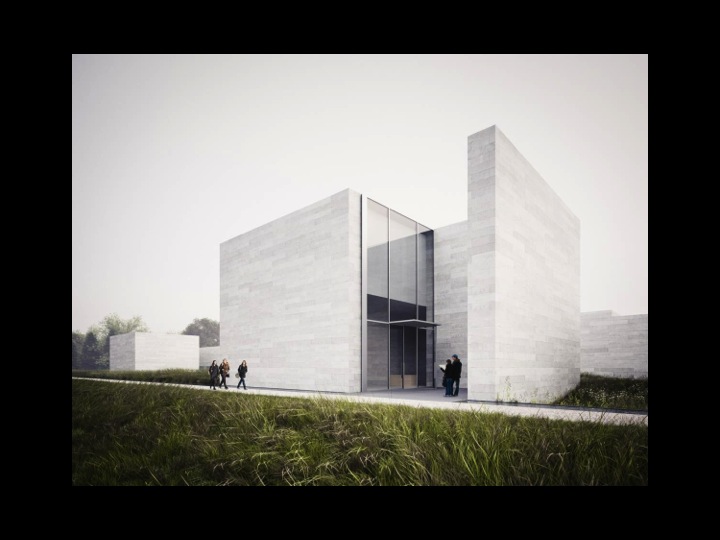
GS: There is a lot of trust, there is a lot of work, there is a lot of back and forth trust and expectation. There are people who have ideas, who come in the morning and say, what about this?

Audience: How do you budget time for research?
TP: We run a small practice. We have never had over 25 people. We have small teams. That’s the only thing I worry about. We don’t do budgeting. We don’t worry about the little bit of hours happening for each task. We just intuitively do the work.
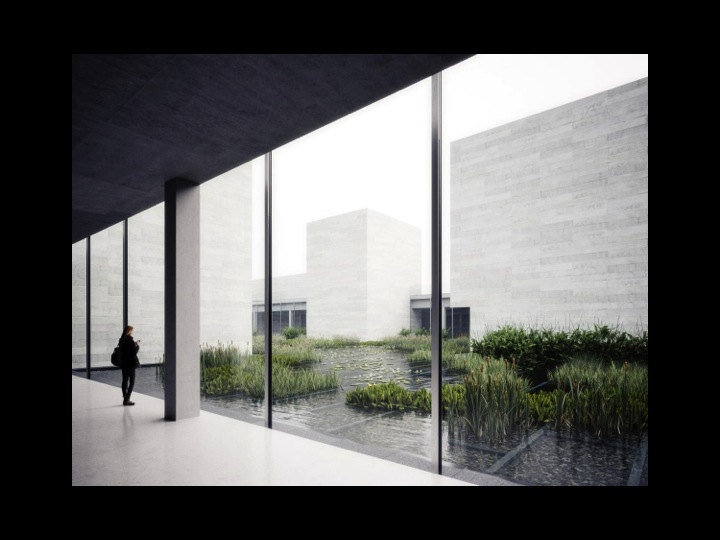
MB: The day I visited your office you had the whole wall completely covered with really beautiful color renderings of this one project. There must have been at least forty or fifty renderings on the walls and also covering the very large table, as well as study models, small and large.
TP: I think that it is clear, probably through this, that this project is a jumping off point for us. When you realize that this is the jumping off point, I think it’s important to spend the time and effort. We have fees like everyone else. We have budgets like everyone else. All of that stuff exists for this project. This family is self-made, and every dollar that is spent here is carefully analyzed. This is not a budget that jumps off the deep end. We have had to do things here that are very simple. Do things like concrete walks that are about seventy, eighty dollars, a square foot. It is not an extravagant building. It is organized differently, but it is not extravagantly finished.
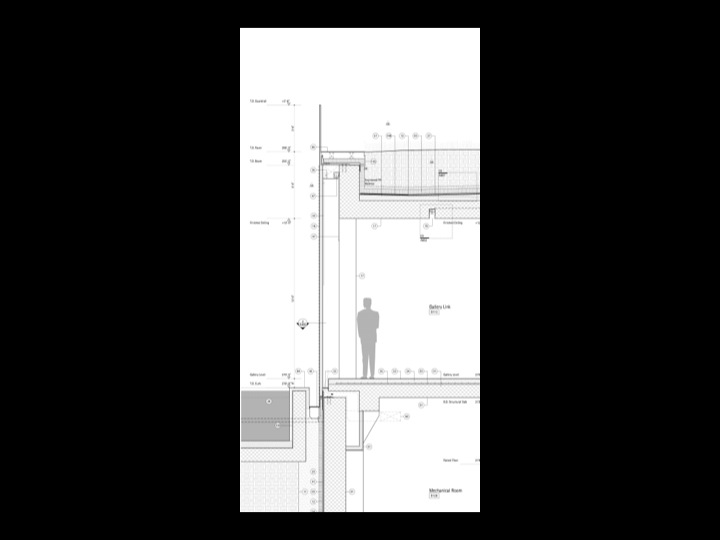
MB: I did ask Gabe to include some details and wall sections.
GS: The concrete block, while it is a very humble, direct material, is up against very, very tall pieces of glass. These pieces of glass are insulated units about 23 feet tall and 9 feet wide. They are very, very large pieces of glass. I think it is the contrast between these enormous pieces of glass that are very, very carefully made and the block that we were chasing for a long time. I think we really came onto something when we found that rich contrast between the high and low.
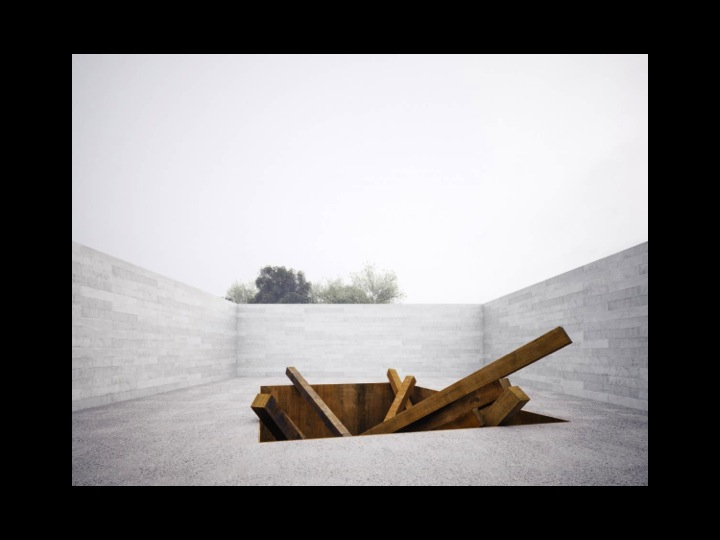

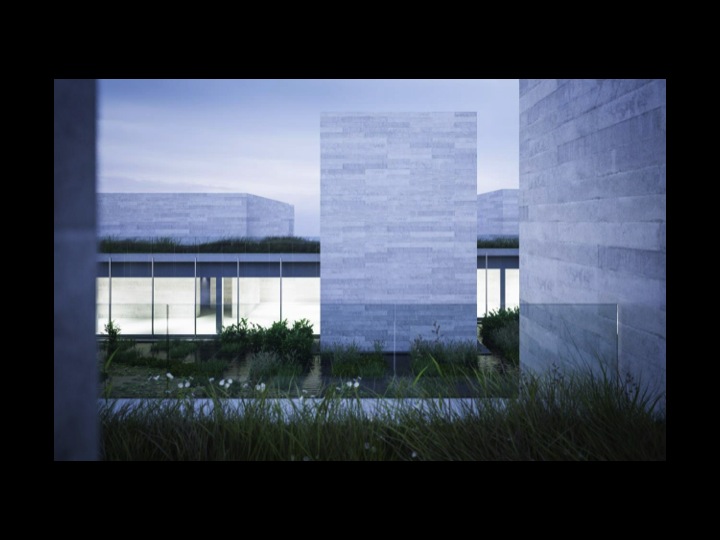
MB: This is a controlled waterscape.
GS: It actually has different depths for different plant species, so where you have higher plants obviously you have different depths.
MB: Who is your landscape consultant?
GS: Peter Walker.
——————————
To learn more about Glenstone, please visit: AAQ Museum Architecture — Glenstone, Potomac, Maryland
————————————————————————————————-
Architectural Sessions is a series of forums sponsored by AIA Peconic and the Parrish Art Museum.
Thomas Phifer & Partners: www.thomasphifer.com
Maziar Behrooz: www.mbarchitecture.com
AIA Peconic: www.aiapeconic.org
Parrish Art Museum: www.parrishart.org
Images courtesy of Thomas Phifer & Partners.
Architectural Sessions — Thomas Phifer & Partners, September, 15, 2013, transcribed & abridged from original video by Jeff Heatley.
Special thanks to Gabriel Smith & Maziar Behrooz for reviewing transcript.

Lichtenstein Theater, Parrish Art Museum. Parrish Art Museum Photos/Copyright, Jeff Heatley.
___________________________________________________________________

